SIGNALS quarterly

The navy in WWI
Personal stories from the war at sea
The silent Anzac
Inside sunken submarine ae2
Norfolk Island
Small place, big history


Personal stories from the war at sea
The silent Anzac
Inside sunken submarine ae2
Norfolk Island
Small place, big history

2015 will mark the 70 th anniversary of i ndonesia’s declaration of independence, and for the museum this presents an opportunity to showcase some important, but now widely forgotten, historical connections between australia and i ndonesia. it is not generally known now in i ndonesia or australia that a series of events just after world war ii led to australia making a significant contribution to i ndonesia’s independence from colonial rule.
t hese events were generated on the ships and waterfront at australian ports, hence my interest. t he australian national maritime museum has just begun work on an exhibition which will record that almost 70 years ago, the waterside workers Federation (now m Ua) and seamen’s Unions decided to enforce a black ban in australian ports on netherlands i ndies ships that carried soldiers and their arms to re-colonise i ndonesia.
t he museum is currently in discussions with the australia i ndonesia a ssociation to co-curate and develop a small exhibition for display in sydney, and a larger project for possible display in i ndonesia.
t his display would mark an anniversary in the achievement of i ndonesian independence and the role that australia played in supporting that independence.
i n 1945–46 Joris ivens, a Dutch film director, made the film Indonesia Calling about this shipping ban in sydney harbour, with many of the original participants re-enacting their roles only weeks after the events occurred. t he then Chifley Government was under significant national and international pressure to ban the film, but allowed it to be shown around the world, therefore greatly publicising the i ndonesian independence struggle. t he australian Government continued to support i ndonesian independence in the United nations between 1945 and 1949.
i n may i had the great privilege to visit a number of i ndonesia museums and cultural institutions in Java and sulawesi to discuss ways the museum can explore our shared maritime heritage. t he i ndonesian archipelago, some 16,000 islands populated
by hundreds of related ethnic/linguistic groups, is home to an extraordinarily rich variety of maritime traditions and trading relationships. i mportantly, some of these maritime trading traditions extended to australia and are hundreds of years old. i n the southern sulawesi city of makassar i visited the museum l a Galigo, where i learnt of the makassan trepangers from the south-west corner of sulawesi who regularly visited the northern australian coast, possibly as early as the mid-1600s, to trade with aboriginal people such as the yolngu of north-eastern a rnhem l and. at the height of the trepang industry in the early 19th century, makassans voyaged thousands of kilometres along our northern coast. i n the museum’s collection is a series of 12 important bark paintings and a large canvas painting that explain the murrankundja (diplomatic) ceremonies performed at the coming of the makassans by the Ganalpingu people of a rnhem l and. t he works are by the artist John Bulun Bulun (1946–2010) and the ceremonies he depicted reaffirm friendly relationships with the makassan traders from sulawesi. some of the works also feature ‘lunggurruma’ designs, which represent the north-west trade winds that herald the monsoonal rains and brought the makassan prahus to australian shores beginning each December.
t he australian national maritime museum will continue to develop partnerships with museums and galleries across i ndonesia, to ensure these often-forgotten stories are more prominently displayed and so can reaffirm the close maritime links that our two countries have often enjoyed over hundreds of years.
Kevin Sumption
ANMM Director Kevin Sumption with Drs Nuryadin, Director of the Museum La Galigo in Makassar, Sulawesi. Photograph Jeffrey Mellefont
Cover: Leading Signalman John Varcoe, John Longstaff, 1921, oil on canvas.
John William Varcoe dsm ran was the model for the sailor statue at the Cenotaph in Martin Place, Sydney. Born in 1897, he earned a Distinguished Service Medal in 1918 for his efforts in maintaining communications aboard the torpedoed Italian steamer Orione while it was being towed by HMAS Parramatta Australian War Memorial Art02996
A sailor’s diary describes the perilous mission of Australian submarine ae2
Inside sunken submarine ae2 for the first time in a century
Maritime cultures and Australian connections on the Indonesian island of Sulawesi
Isolated colonies linked by food, famine and a famous shipwreck
endeavour’s role in the creation of a botanical masterwork
A new statue marks the bicentenary of the renowned navigator’s death
An evocative journey aboard America’s last wooden whaleship
A celebration of Indigenous art and culture
The latest exhibitions in our galleries this season
Your chance to join the endeavour replica on a series of sailing adventures
Excursions on – and occasionally in – the ice of Antarctica
The genesis of a classic Australian leisure craft, the tinnie
Australia’s first European inhabitants – 159 years before the First Fleet
French Designs on Colonial New South Wales; That Summer at Boomerang
Vale
Internet sleuths put a name to a face
visits from John Kerry and James Cameron

‘At 6am the captain remarked that the next few minutes might see us sailing off for Kingdom Come after our halos and wings’
The role and experiences of sailors during World War I have often been overshadowed by stories of Anzacs at Gallipoli or Diggers on the Western Front. The museum’s new exhibition War at Sea –The Navy in WWI focuses on personal accounts of action on and below the waves during the Great War. Through the dramatic diary entries of one of its crew, curator Dr Stephen Gapps recounts the dangerous mission of Royal Australian Navy submarine AE2
the stOries OF sailOrs in the royal australian navy (ran) spring from the pages of their diaries, memoirs and journals – some of them pocket books with brief notes, others detailed descriptions of daily life at sea. some are punctuated with intense periods of action such as the battle between hmas Sydney and the German battleship sms Emden. Others are full of complaints about the drudgery of patrolling and blockading or the impossibly hard consistency of ‘salt biscuit’ rations. t hese diaries are a wonderful insight into life in the navy, and as first-hand voices from the past they also resist re-interpretation after the events by historians and others.
One of hundreds of war diaries that have never been published – and one of the comparatively few accounts by sailors –is that of stoker Petty Officer henry (harry) James elly k inder. it is also one of a handful by submariners from the war. k inder’s dramatic account of forcing an underwater passage of the Dardanelles strait – at the
same moment as the a nzacs were landing ashore at Gallipoli – is the focus of this article, and one of the many engrossing personal stories from the exhibition.
henry k inder was born in kogarah, sydney, in 1891. he joined the colonial navy aged 17, entering the submarine service four years later, in 1912. two e -Class submarines had been ordered and constructed in Britain for the new fleet that was to be the backbone of australia’s own naval force – the royal australian navy. submarines were a relatively new arm of the force – in 1901 the idea of submarine warfare was considered by senior personnel in the British admiralty to be ‘underhand, unfair and damned un-english’, in the words of admiral sir a rthur wilson vc. t hey were also still somewhat experimental and not the safest of vessels to serve on. k inder joined submarines for the ‘extra allowances as danger money’ – what sailors called ‘blood money’.
‘When the boat is lying on the bottom with only a pilot light on, one begins to imagine all sorts of things happening’
k inder was an artistic young man who used his downtime in the navy to create fine embroideries. he also had quite a turn of phrase and a wonderful memory of a journey ‘so impressed on my mind that it is not easily forgotten’. AE2 ’s incursion into heavily mined turkish waters on 25 april 1915 was certainly a harrowing one that affected the 34 crew members for the rest of their lives.
when war began in august 1914 the submarines AE1 and AE2 were sent with the australian naval forces attacking Germanheld colonies in new Guinea and other Pacific islands. k inder had initially been assigned to AE1 but due to ‘marriage leave’ ended up on AE2 – a fortunate turn of fate. k inder wrote:
On 14th September, 1914, ae1 went out, accompanied by a destroyer, on what was to be her last journey. Little we thought, when laughing and joking with the crew just before she left, that it was the last time that we were going to see them.
AE1 was on a routine patrol and did not return. it was lost with all hands off the coast of r abaul, new Guinea, and has never been located.
‘Fortune Favours the Brave’
a fter the German Pacific colonies were quickly taken by the australian naval and m ilitary e xpeditionary Force, AE2 was directed to the mediterranean where a grand naval assault was planned on the Dardanelles strait prior to the Gallipoli Campaign – a campaign that might not be needed if the a llied fleet managed to break through the heavily mined and fortified strait.
But this assault on 8 march failed and the turkish celebrated a great victory against the might of Britain, as they still do each year on that date. Concealed minefields destroyed several a llied ships. k inder recalled:
…it wasn’t a bad day’s work for the Turks although they too suffered as a lot of their forts were blown up. It showed that the forcing of the Dardanelles wasn’t going to be an easy job as it was well fortified by land and water.
t he job of forcing the straits was given over to submarines. Just as the Gallipoli landings on 25 april were about to commence, AE2 was tasked with trying to get through to create havoc among turkish shipping

in the sea of marmara and assist with delaying reinforcements from eastern turkey crossing to the Gallipoli peninsula.
t he dangers were immense. several submarine attempts had already failed, and AE2 ’s first effort on 24 april met the same fate. k inder wrote:
One of the knuckle joints on the driving shaft snapped. This block is a 4 inch square piece of steel which prevents the hydroplane from moving in a rough sea or when running on engine power. The slightest incline would drive the boat under and then there would be another submarine disaster. What the captain said when he heard the extent of the damage would fill a book but I doubt if it would be readable.
But with running repairs, AE2 tried again the next day. k inder noted that every submarine had a motto: ‘ae2’s was “Fortuna Favet Fortibus” or “Fortune Favours the Brave”. with a motto like that we ought to have some kind of luck.’
i n the early hours of 25 april, just as a nzac troops were moving from ships into landing barges, AE2 crept into the Dardanelles strait. k inder described the beginning of the voyage:
The captain ordered the boat to be taken to 80ft [24 metres] so as to be well clear of any shipping or floating mines which float about eight or nine feet under the water. Our greatest danger was running onto banks or getting entangled in wire hawsers. Everything was very quiet for the first two hours and only an occasional order from the captain and the hum of the motors broke the stillness. Strict silence is maintained by the crew so that no order is missed.
The captain, every twenty minutes or so, brought the boat up to the 22ft [7 metre] mark to take observations through the periscopes and see that we were on the right course; then down again to 80ft, well out of sight.
At 6am the captain remarked that the next few minutes might see us sailing off for Kingdom Come after our halos and wings. We were approaching the place marked on the chart where there were two stationary mine fields, each containing nine rows of mines. Mines are one of the most dreaded things in submarines. It was not pleasant to know that we had to face eighteen rows of them.
Just after 6am AE2 scraped the first wire. k inder recalled that ‘it was enough to stop
01 A postcard showing the crew of the newly completed submarine HMAS AE2 in Portsmouth in early 1914. It was sent by Lieutenant Geoffrey Haggard to a relative in London. Haggard wrote on the back: ‘HMA Submarine AE2, at sea March 11th … am now in the Mediterranean ½ way to Malta … Isn’t the sub topping?...’ ANMM Collection Gift from Mrs D Smyth (nee Haggard)
02 Officers and crew of submarine AE2 at Portsmouth, February 1914. Harry Kinder is front row, far right. Australian War Memorial P01075.045
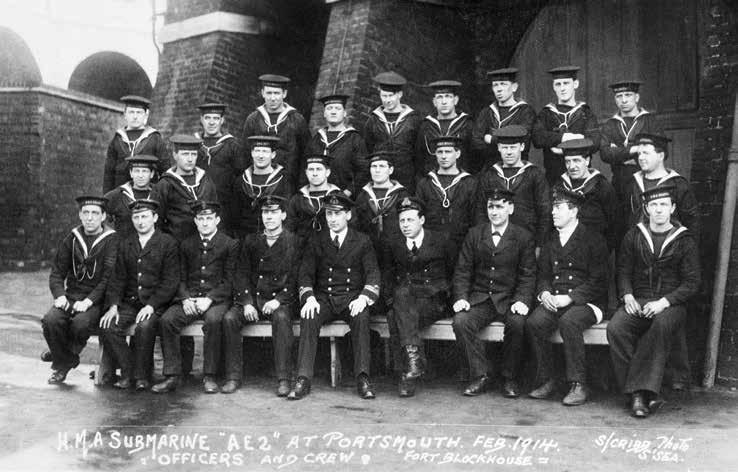
‘What the captain said when he heard the extent of the damage would fill a book but I doubt if it would be readable’
one’s heart beating to hear it sliding over the steel deck’. he kept count of the wires as the boat hit them and ‘on the eighteenth we guessed we had passed through our first danger’.
t he next thing was to pass the ‘narrows’ with its swift current, banks, shallows and overlooking forts. it was here that the British submarine E15 had ‘met her fate’ a few days before.
Stirring up a hornets’ nest
at this point, the captain of AE2, Commander henry stoker, saw several turkish cruisers at anchor and decided to ‘have a shot’. k inder wrote:
The bow torpedo tube was got ready but just as the torpedo was discharged a mine layer steamed across the cruiser’s bows and got in our line of fire. Unfortunately for her, she stopped the torpedo. It must have been an unpleasant surprise for them so early in the morning. As soon as the torpedo was fired the captain ordered the sub down to 80ft to get away from the hornets’ nest we had stirred up on top.
But the discharge of the torpedo had affected the vessel’s compass and AE2 was 80 feet under water and running blind. surfacing to gain bearings was too dangerous, as they were in front of the turkish forts, but the narrows forced their hand – as the bottom was felt, AE2 rose but became stuck on a bank and surfaced right under turkish guns.
k inder noted that in one sense they were fortunate, being so close inshore that the forts’ guns could not be successfully trained on them. with all the ballast tanks blown and the motor full speed astern, gradually AE2 bumped off the bank. t he tanks were again flooded and slowly the vessel sank back down to 80 feet.
Lying low and running amok
AE2 had indeed stirred up a hornets’ nest. with an array of turkish vessels desperately searching for it, stoker decided to rest the vessel on the bottom. it was 8 am on sunday morning. t he crew had breakfast and some sleep, then rose for morning prayers at 11 am. k inder wrote, ‘i dare say it was the first time prayers were read on the bottom of the sea.’
Commander stoker decided to wait for nightfall so they might surface with less risk. turkish vessels dragged lines searching for the submarine throughout the day. a destroyer passed only a few feet over their position – so close the AE2 crew could ‘hear the stokers opening the furnace door and shovelling coal into the fires’.
k inder continued:
There was no more sleep for us as it got on our nerves to hear the boat persistently going backwards and forwards. Once the drag hit the boat and for one awful moment we waited anxiously to see if the destroyer would stop but when we heard her continue on her way we knew the drag had not caught. If the drag had held it would have been the end of ae2 and her crew as a depth charge would most likely have been our fate.
towards the end of the day the air inside the submarine was ‘getting thick’. AE2 had been submerged for 14 hours and carried no oxygen to renew the air.
at 10.30 pm Commander stoker decided it was quiet enough above to continue. For k inder, ‘action was far better than lying on the bottom imagining all sorts of things happening’. when the vessel surfaced after 18 hours submerged, the crew were joyous. ‘what a relief it was … how nice that fresh air tasted.’
01 Lieutenant Geoffrey Haggard and Commander Henry Stoker of AE2 in 1919. The laconic inscription – ‘Jolly old AE2 after 3½ years as hosts of “The Unspeakable One”’ – belies the suffering they and the other crew members endured as prisoners of war. ANMM Collection
02 AE2 in the Sea of Marmora [sic] April 1915, Charles Bryant, 1925. This painting shows submarine AE2 after it had broken through the Turkish defences of the Dardanelles Strait and was boldly ‘running amok’ in the Sea of Marmara. The pendant number ‘82’ on the conning tower was actually allocated to the British E Class submarine E2. It is probable that Bryant wanted to indicate the broader role and success of the Allied E Class submarines during the Gallipoli campaign. Australian War Memorial ART09016
to k inder, it had seemed AE2 had been on the surface an hour rather than just a few minutes. ‘at ordinary times i didn’t care to be down under water but i was thankful to see the gauge registering 80ft once more’.
yet after escaping one side, and still travelling blind, AE2 careened into the opposite bank – again forcing its way off and gaining bearings before turkish gunfire could target it. t heir luck continued as the compass ‘became sensible again’ and Commander stoker continued towards their goal of the more open sea of marmara.
a fter sitting on the surface and recharging batteries, finally, at daylight on 26 april, AE2 headed into the sea of marmara and a sense of security, with open water to escape in. k inder recorded the moment:
It was a beautiful day and the Sea of Marmara was like a sheet of glass … it was lovely to sit on the saddle tanks in the sunshine … We seemed to have the Sea of Marmara to ourselves.
now, out of the dangers of the narrows, mines, current, forts and depth charges, AE2 was in the box seat – brazenly travelling on the surface scaring off local shipping and turning back transports with


‘Mines are one of the most dreaded things in submarines. It was not pleasant to know that we had to face eighteen rows of them’
01 World War I scarf printed with a map of the Turkish Empire (marked ‘Turkey in Asia’), and surrounding countries. At lower right an inset map shows the Dardanelles, and notes Gallipoli and the forts along the shoreline. ANMM Collection

enemy troops heading towards Gallipoli. stoker had been ordered to ‘run amuck’ [sic] if he made it through.
‘A big, wounded fish’
a fter spending the next night submerged, then scaring off several more transports the next day, stoker saw an opportunity and fired a torpedo at a transport vessel. its escorting destroyers then attempted to ram AE2 and as the submarine dived, a destroyer’s propellers sounded so close that ‘we ducked our heads to allow it to pass’.
a nother night was spent lying on the bottom. k inder reflected that:
When the boat is lying on the bottom with only a pilot light on, one begins to imagine all sorts of things happening… Perhaps it would not be able to rise again with the crew caught like rats in a trap with no hope of escape. If you let your imagination run too long you can feel your hair rising … Sometimes the sound of a voice is a welcome sound.
t hen on 29 april, in a moment of utter surprise and almost disbelief, a British submarine was spotted. E14 had also run the gauntlet in AE2 ’s wake. t he two commanders then agreed to separate and rendezvous the next day.
But this meeting was not to occur. t he next day, on nearing the appointed rendezvous, two turkish gunboats and a destroyer were sighted making a bee-line for AE2. when the vessel dived, something was wrong – the boat started to go down by the bow. it was impossible to stand; ‘everything moveable in the boat started to slide and roll to the bows’.
eventually, after all the ballast tanks were blown and with the engines full astern, AE2 began to rise. But circling above were turkish warships. AE2 surfaced with a ‘whoosh’ and stoker quickly flooded the tanks in order to dive again, hoping this time to dive correctly. But luck had seemed to finally desert AE2
Just as it was about to submerge, three shells hit the vessel. water was flooding the engine room. AE2 descended and after a hard struggle, the watertight doors to the engine room were closed. t he vessel went down to 80 feet and then stopped. would the flooded engines keep going? without them AE2 could not surface.
Many things flashed through my mind in those few minutes. I could picture ae1 and her crew under similar conditions fighting for their lives with all the boat in disorder. Although they couldn’t have lived long … and the boat’s hull would soon have been crushed under the enormous pressure … Still, they must have suffered agonies in those few seconds. We would be lucky if we did not share the same fate.
t hen AE2 began to rise. Perhaps luck was still with them. But on the surface the crew soon realised AE2 ’s end had come. while stoker gave the order to abandon ship, the two gunboats were still firing and shells were falling all around.
henry k inder spent his last few minutes looking around the boat. he noticed the clock at five minutes to 12, and recalled there was a rabbit pie in the oven. he left the pie and went to his ditty box to retrieve 16 shillings and a photograph of his wife.
On deck, k inder saw Commander stoker come up after opening the kingston valves to scuttle the vessel. t hey then dived overboard with the rest of the crew. For a few seconds k inder saw AE2 ‘moving through the water like a big, wounded fish, gradually disappearing from sight’.
t here was only one casualty – a large rat that the cat at Garden island in sydney had chased on board one morning when the submarine was lying alongside. t he rat took up residence in the engine room and the crew fed him to stop him eating their own food.
i n what Commander stoker agreed was a surreal moment, k inder noticed that l ieutenant haggard had lit a cigar just before leaving the boat and he recalled that haggard looked rather comical floating around amid clouds of smoke. stoker remembered a different moment:
Curious incidents impress one at such times. As those last six men took [to] the water the neat dive of one of the engine-room ratings will remain pictured in my mind forever.
t he turkish torpedo boat Sultanhisar under Captain r iza took the crew prisoner. t hey remained in captivity for the rest of the war. r iza later wrote his own version of events in his book How I sank the ae2
henry k inder recounted much of his time in the camps in his memoir, but said
‘there were many incidents that happened during the time that we were prisoners that i will not be able to write down here’.
he apparently never spoke about these events after the war. k inder returned to australia a broken man, having suffered kidney damage, malaria and severe beatings in the camps. he left the ran in 1919 and moved with his wife to Dorrigo and then Casino in northern new south wales.
i n later life he moved to evans head where he apparently became increasingly eccentric and entertained the locals by making large beach-sand drawings and sculptures. h is artistic nature was still with him. henry k inder died on 25 april 1964 – a nzac Day.
l ieutenant Geoffrey haggard kept a ‘black book of notes’ after the war, though he never published them. according to his daughter, haggard remained deeply troubled by the events of 1915. AE2 sent a wireless signal through to say the vessel had breached the Dardanelles strait, and it has been argued that this news had a role in firming the a llied commanders’ resolve to continue the Gallipoli invasion, rather than evacuate in the early stages. t he resulting carnage haunted haggard for the rest of his life, resulting in a long personal silence for this crew member of submarine AE2, the so-called ‘silent a nzac’.
Further reading
Fred and Elizabeth Brenchley, Stoker’s Submarine – Australia’s daring raid on the Dardanelles on the day of the Gallipoli landings, Australian Teachers of Media, St Kilda, Victoria, 2001, 2013
Henry Hugh Gordon Stoker, Straws in the Wind, Herbert Jenkins, London, 1925
Jennifer Smyth, The Long Silence – The story of G A G Haggard of Submarine AE2, Spectra Litho, Toorak, Victoria, 2007
HMAS AE2 was one of two submarines deployed by the fledgling Royal Australian Navy in World War I. In the early months of the war, AE2 boldly penetrated the perilous Dardanelles Strait in Turkey – the first Allied vessel to do so. Scuttled in April 1915 , AE2 has lain at the bottom of the Sea of Marmara ever since. Cameras recently saw inside the submarine for the first time in a century thanks to Project Silent Anzac, a collaboration between Australian and Turkish institutions. The museum’s Head of Research Dr Nigel Erskine was there, and profiles the expedition.
visitinG Galli POli tODay and standing at the beautiful memorial at a nzac Cove looking over the blue waters of the aegean, it is difficult to appreciate how different the place was in 1915 when australian troops played an important part in the British and a llied attempt to seize the Gallipoli peninsula and thereby take the Dardanelles – the narrow channel controlling access between the mediterranean sea and the sea of marmara, which leads to istanbul and the Black sea beyond. a plaque at the site provides a succinct history for the thousands of tourists who each year visit the peninsula. it states in part:
The Allied objectives in the Gallipoli Campaign were, by capturing Istanbul, to force Turkey out of the war, to secure an ice-free supply route to Russia and to open another front against Germany and Austria-Hungary … The Royal Navy, with the assistance of the French Navy, played a vital part throughout the campaign. The Navy was responsible for landing and finally evacuating the troops and their stores; for protecting the wholly sea-borne lines of communication; for giving support to the troops by bombardment from the sea; and, principally by a series of daring exploits by submarines in the Sea of Marmara, for effectively preventing intervention by the Turkish Fleet.
i n June i had an opportunity to learn something of the exploits of one of those submarines when i joined Project
silent a nzac as part of the final maritime archaeological assessment of the sunken australian submarine AE2 t he project aims to preserve, protect and tell the story of AE2 i n June the team’s aim was to open the hatch of the submarine and to capture high-resolution images from inside the boat using remote-operated vehicles (rOvs), sonar imaging and high-definition cameras.
a fter successfully passing through the narrows of the Dardanelles (see article on page 2), AE2 was critically damaged in an encounter with the turkish torpedo boat Sultanhisar on 30 april 1915. with the pressure hull pierced by shell fire, the submarine was inoperable and Commander henry stoker ordered the crew to abandon ship, then purposely scuttled the boat to stop it falling into enemy hands. AE2 quickly sank in around 73 metres of water, where it remained untouched until finally located in 1998 by the turkish diver selçuk kolay using sonar equipment.
l ater that year a group of australian technical divers led by Dr mark spencer surveyed and photographed the exterior of AE2, noting in the process that the submarine’s conning tower hatch remained slightly open, just as it had been left by Commander stoker when he abandoned the submarine in 1915.
no crew were lost when the vessel was scuttled, but speculation about what might survive inside the submarine and how best to preserve AE2 ultimately led to the

It was spellbinding to watch the rubbery marine growths attached to parts of the deck and superstructure

01 Part of AE2 ’s hull covered by marine growth.
02 Forward periscope pedestal.
03 The resident conger eel, Bunts, keeps a watchful eye on proceedings. ‘Bunts’ is a naval nickname for the ‘bunting tosser’, or signalman. Albert ‘Bunts’ Thomson was the signalman on AE2 His grandson John was a member of the expedition in 1998 and may have been party to naming the eel that had taken over his grandfather’s workspace in the boat.
04 Elliot Brothers of London Patent ship’s speed indicator and log in AE2 ’s control room.
05 Starboard ballast pump controller and gauge.

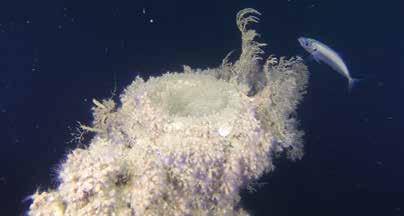


The atmosphere in the monitoring shed was electric as each new object appeared on the screens

01 Craning the temporary diver support platform (DSP) over the side. This was placed adjacent to AE2 ’s conning tower to provide a working platform for the divers. The diving bell is in the foreground. Photograph Nigel Erskine/ANMM
02 A diver (in yellow helmet) is assisted into the diving bell.


formation of the AE2 silent a nzac Project led by retired submariner rear admiral Peter Briggs. t he project brings together the expertise of the australian submarine i nstitute (asi), scientists and engineers from the Defence science and technology Organisation (DstO), rOv manufacturer seabotics, archaeologist tim smith, conservation specialist Dr ian mcl eod, plus an experienced team of turkish commercial divers to carry out the work under water.
Before arriving in turkey the team had developed a range of cameras, an rOv and other equipment specially designed to get inside the submarine and to record its interior. a nother invention was a dive platform designed to sit close to AE2 ’s conning tower, providing a safe and stable working platform for divers. On the surface, the ship Kaptani Derya 2 supported all diving operations, and was a home-awayfrom-home for the project.
Due to the depth, the divers have only just over 20 minutes to complete their work before slowly returning to the surface with several decompression stops
t he project goals this year were to inspect the exterior of the submarine for any damage caused by trawlers; to take corrosion readings on the hull to establish a datum for measuring the long-term effect of installing cathodic protection (zinc anodes) around the hull; to open the conning tower hatch and insert cameras and sonar into the main control room below the conning tower; and finally to ‘fly’ a small rOv into the control room spaces to record the interior of the submarine for the first time in almost 100 years.
with the ship held in place exactly above AE2 by four large anchors, one of the rOvs was sent down to locate the submarine. t he rOv is fitted with cameras that send images through a cable to the surface, where they are shown on monitors mounted in a temporary shed on the ship’s deck. it was spellbinding to watch the rubbery marine growths attached to parts of the deck and superstructure. a fter this initial inspection the dive platform was craned over the side and carefully manoeuvred into place using the rOv, to great effect. having successfully completed this task it was time to send the divers in to do a visual inspection of the area around the main hatch.
a ll diving on the project was done from a dive bell. a s the name implies, the bell is a tubular pod in which two divers are lowered to the working platform. Only one of the divers undertakes the assigned task; the other stays in the bell to provide backup if required and to watch over operations. Due to the depth, the divers have only just over 20 minutes to complete their work before slowly returning to the surface with several decompression stops. t he last stage of decompression is completed aboard the ship in a hyperbaric chamber under the watchful eye of the doctor and her technical assistants. t he process is slow and limits diving to just three dives a day.
Conditions throughout the two weeks of diving were ideal and each day produced a little more progress towards sending the rOv inside AE2 t he conning tower hatch had been expected to create difficulties, but in the event it opened relatively easily, revealing the interior of the conning tower. By this stage there was a palpable air of excitement surrounding the DstO team as they prepared the rOv and finally sent it down.
a nyone old enough to remember the excitement of the first moon landing will understand something of the anticipation as the rOv was manoeuvred into the conning tower for the first time. it was
immediately obvious that the interior of the conning tower was preserved in an extraordinary state, with very little concretion build-up. even timber cabinetwork (perhaps the flag locker) had survived. AE2 ’s engine telegraph, light fittings, gauges and other fittings all came to life as the rOv ’s cameras and lights rotated slowly through 360 degrees. t he atmosphere in the DstO monitoring shed was electric as each new object appeared on the screens.
t he next day the mood aboard the ship was optimistic. t he weather was unchanged and after the previous day’s success it seemed a relatively simple task to lower the rOv through the next hatch and into the main control room. But, as so often happens, nothing is that simple! it soon became apparent that some unexpected protrusions prevented the rOv from fitting though the lower hatch. t his was disappointing, but luckily the scientists had brought a second, smaller rOv as well. while the cameras on board this rOv were inferior to those of the larger machine, it passed through the lower hatch easily and was soon sending back excellent footage of the control room.
i n the days that followed, the team was able to complete all the remaining tasks and leave turkey with an enormous amount of footage and stills imagery to examine in detail in the months ahead. AE2 is a real time capsule and it was a privilege to be a part of the project.
next year, when Project silent a nzac concludes, the australian national maritime museum will receive the project’s extraordinary archive of film and other data recording the condition of the submarine and become responsible for continuing the positive relations between australia and turkey that have been established by the project.


In June a group from the museum visited the tropical Indonesian island of Sulawesi – formerly known as the Celebes – to explore its fascinating cultures and its historical maritime connections with Australia that date from pre-European times, writes tour leader Jeffrey Mellefont .
the massive , U n PainteD timber hulls lay side by side with their extravagantly raked stems pointing towards the sea across a flat beach of powdery white sand, while palm fronds moved in the steady east monsoon wind. you could almost call it a tropical cliché, except for the detritus of boatbuilding – and the plastic bits and bottle tops and lost thongs that wash up just about everywhere these days. But for all that it was a scene to tickle anyone’s nautical fancy: an impromptu shipyard without gates or fences, to serve a community of hereditary shipwrights. here, keels were laid upon coconut logs dropped casually onto white sand at the water’s edge, wherever timbers shipped from distant tropical forests in Borneo or new Guinea could be floated ashore. shipwrights, dwarfed beneath towering topsides, wrestled planks and frames by hand and hammered them together with treenails.
Our museum group of 15 travellers had come all the way from australia to see this beach, on the southernmost tip of the i ndonesian island of sulawesi. it’s a place where timber boats have been built in a very similar fashion, right there beneath the coconut palms, for many, many hundreds of years. a nd it’s a beach that for hundreds of years had launched fleets of timber boats to sail across the horizon in the direction that these raked stems, lined up before us, were pointing – all the way to northern australia.
we were in the district of the konjomakassan clans, famed throughout i ndonesia as shipwrights – although they’re just one of the many seafaring cultures of the tropical i ndonesian archipelago. together with sailors from other kingdoms of south sulawesi – most notably their entrepreneurial trading kinsmen and rivals, the Bugis – makassans had taken part in seasonal voyages to australia’s top end in pursuit of one most extraordinary fishery. From at least the 17th century they sailed off each year and worked with coastal i ndigenous people of australia’s northern littoral to gather and preserve slimy, cucumber-sized sea slugs that they call teripang. europeans, when they arrived considerably later in this historical tale, would know the ugly invertebrates as Holothuria, bêche-de-mer or trepang.
t hese voyages of south sulawesi’s makassan and Bugis sailing clans, up to 1,000 nautical miles each way, harnessed the great monsoon weather system that stretches from tropical australia and a sia across the i ndian Ocean all the way to a frica. For half the year its winds blow from the eastern quadrants before reversing into the west
for the other half. it was this predictable, climatic return-ticket that powered the wider international trades in spices and other valuable eastern products for much of history. a nd down in a remote corner of this world of ancient monsoon trade routes – on a distant coast that the sailors from sulawesi called Marege, the land of black people – was one very specialised trade that connected a rnhem l and and the Gulf of Carpentaria with the courts of i mperial China.
For Chinese gourmets the fat varieties of sea slugs or teripang found in shallow, tropical australian waters were expensive delicacies with medicinal and aphrodisiac properties. i n the dry season the makassans set up annual camps there and with the consent and help of their aboriginal hosts they collected and then laboriously boiled, sun-dried and smoked the catch, preserving them for the voyage back to sulawesi’s international trading port called makassar. here the teripang were transferred into Chinese junks that came down on a different branch of the monsoon wind system, exchanged for goods such as blue and white Chinese trade porcelain which our group saw in museum collections around south sulawesi. t he rock-hard, dried teripang were ultimately soaked, softened and simmered for broths and hot-pots in distant Chinese kitchens – and examples of this curious trade commodity can be seen in the showcase of the australian national maritime museum that tells this story of early international maritime connections. it was these themes that were central to the museum’s recent members-program tour of south sulawesi. it’s a story that goes well beyond maritime trade, for over the centuries there were complex cultural relations between the visitors and the i ndigenous people who received them.
t he makassans left legacies that included new technologies, materials and foodstuffs, language and practices. most importantly, they left descendants and thereby became ancestors. aboriginal people sometimes sailed back to sulawesi with the visitors. t he makassans are remembered in i ndigenous ritual, performance and art, long after the voyages were forbidden in 1906 by customs officials of the newly federated and determinedly ‘white’ australia.
t his connection is not well known either in australia or i ndonesia, and during the two weeks that our group explored the province of south sulawesi we often had the opportunity to surprise our i ndonesian hosts with such histories. t hat fitted well with the broader purpose for our tour,
Northern Australia and Indonesia have always occupied a common maritime zone and their fortunes will continue to be linked by these seas
which was to give a group of australians an intensive experience of the complex country next door, while introducing the i ndonesians we met to a thoughtful group of their own neighbours.
it’s certainly true that these two large, neighbouring nations, australia and i ndonesia, with their very different cultures, histories and geographies, do not really know each other all that well. i ndonesia has been preoccupied, in the decades since it freed itself from colonial Dutch domination, with raising the living and educational standards of its very large and culturally diverse population. most australians, traditionally focused on distant europe and a merica, know little more of their northern neighbour than the overdeveloped tourist quarter nearest Bali’s international airport. i ndonesia is poorly reported in our media, and political relations have often been mishandled. yet modernising, populous i ndonesia offers us many opportunities as its economy matures. stretching across our northern sea lanes as both a gateway to the a sian region and a buffer zone as well, it holds great strategic value – particularly as its muslim majority continues to come down largely on the side of democracy and moderation. a nd what makes international relations with i ndonesia the concern of a maritime museum? well, consider a nation that comprises 16,000 to 18,000 islands (the number continues to change depending on the tide, sea levels, and tectonic and volcanic activity). t hey cover an area that’s as extensive as the australian continent and even wider. about 6,000 of the islands are inhabited in a patchwork of some 300 languages and cultures, most of them sharing the common ancestry of a seafaring people who began island-hopping out of southern China some 5,000 years ago.


01 Previous pages: Makassan boatbuilding at Bira, continuing on the same beaches that launched fleets to Australia’s north in pursuit of a centuries-old international trade. Can you spot the Members dwarfed by these 1000-tonne hulls? Photography this page and opening spread by Jeffrey Mellefont
02 Villagers from the floating fishing hamlet of Lake Sengkang, which the group visited by chartering a whole fleet of the lake’s working sampans.
03 Typically friendly young residents of Makassar, the old trading entrepôt that is now the capital of a youthful and dynamic province. Its waterfront was recently upgraded with this new ‘floating’ mosque, Mesjid Amirul Mukminin (‘Commander of the Faithful’).
01 Rock-hewn burial chambers and effigies of deceased ancestors at Lemo in the spectacular Toraja highlands, home of a fascinating megalithic culture. Photography this page by Robert Osmond
02 The hereditary Rajas of the kingdoms of Sulawesi, formerly part of a complex aristocratic web that made up the East Indies prior to its emergence as the unitary, independent Republic of Indonesia.
03 Tour group from the Australian National Maritime Museum with the Wajo-Bugis dancers and musicians who performed exclusively for us at a welcoming feast in Sengkang.

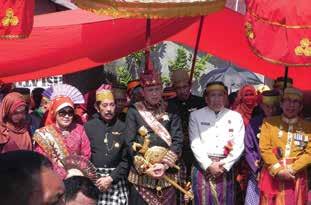

Over the centuries there were complex cultural relations between the Makassan and Bugis visitors and the Indigenous people who received them
r ival kingdoms of Bugis and makassan sultans battled each other, and european interlopers, to dominate it. Our tour’s title ‘Celebes sailors, ships & spice’ referenced the colonial european name for the island – the Celebes – recalling a period when Portuguese, spanish, english, French and Danish traders mingled there with malays and a rabs until the city’s conquest by the Dutch and their expulsion of rivals from 1667. t he magnificent Fort rotterdam, where our tour began, was built soon after and is one of i ndonesia’s largest, finest and best-kept heritage relics of that tumultuous period.
– a land of pagoda-shaped mosques and stilt-houses with horned rooflines. at sengkang we rode longboats to the floating villages of l ake tempe where, as in several of our destinations, we enjoyed home-cooked local cuisine. i n watampone we were invited to morning tea in a former r aja’s palace and heard first-hand from its prince, a ndi Baso Boné, about ancestors who had carried their royal household’s banner to Marege – northern australia – in olden times.
with a long, defining heritage of maritime communities and kingdoms, i ndonesia is an archipelagic nation for which maritime transport, communications and subsistence are vital. it’s intersected by critical regional and global sea-lanes, many essential to our own interests. australia too is definable as a maritime entity – an island nation with no land borders whatsoever, dependent on its surrounding seas for the movement of exports and imports, for fisheries and mineral resources, and for the conduct of national security. Both nations share a maritime boundary that has at times been problematic, and across which occur maritime events that can create difficulties.
Our tour focused on one small part close to the centre of this sprawling maritime entity – the island of sulawesi, which is draped like an orchid across the equator, and was formed just a few million years ago by the collision of the australian and southeast a sian tectonic plates. it lies along a lfred russell wallace’s famous geographical line which marks the division of the flora and fauna of these two worlds. Our group from the museum visited a beautiful waterfall where this great British naturalist collected butterflies in 1856, amid the upthrust of ancient corals that form the island’s dramatic limestone spine.
sulawesi’s cosmopolitan southern capital makassar, formerly called Gowa, was a major port for the spice trade.
Our group was honoured by a warm personal welcome from director Drs nuryadin of Fort rotterdam and its museum l a Galigo, named for the literary epic and foundation myth of the Bugis and makassan cultures. we later found ourselves the unexpected guests of the hereditary rajas of south sulawesi’s traditional kingdoms, at a spectacular coronation ceremony held in a sacred royal compound on the city’s outskirts. t hese kingdoms were formerly part of a complex mosaic that made up the east i ndies prior to its emergence as the independent republic of i ndonesia, and the coronation we witnessed was the first to be held here since the 1930s. t he coexistence of such traditional ceremony and regalia with the dynamism of a modernising state was fascinating.
Our first encounters with sulawesi’s celebrated boatbuilders and seafarers were in makassar’s traditional perahu port, Paotere, home to the massively built timber traders known as pinisi tramping all over the archipelago, particularly to remote island ports too small for regular industrialised shipping, they are part of what’s probably the world’s largest remaining wooden fleet. t heir auxiliary gaff masts and topmasts and tripartite timber bowsprits recall the engineless pinisi from which these modern motorsailers evolved just a few decades ago. t hose old ketch-rigged pinisi are celebrated as the icon of maritime i ndonesia, reproduced everywhere as models or murals or portraits, and often cast in concrete as civic monuments in the middle of town squares.
Our itinerary also took us into highland valleys of clove and coffee plantations and rice terraces to visit torajaland, with its spectacular domestic architecture, mysterious ancient megaliths and solemn grottos of the dead. Descending to the Bay of Boné we transited the old Bugis kingdoms of luwu, wajo and Boné where islam first arrived in the early 1600s
i n tana Beru, motorised cargo ships, ferries, fishing and dive boats were being constructed of tropical timbers under palmleaf shelters stretching over a kilometre of dazzling white-sand beach. here we enjoyed the generous muslim hospitality of a master konjo-makassan boat builder, haji Jaffar, now 80 and retired. i had first met him in the 1980s when he was commissioned to build a replica of a 19th-century makassan voyaging perahu, which sailed to Darwin and is preserved in the northern territory museum. Power drills and chainsaws now augment the hand adzes and augers that haji Jaffar used, but today’s perahu are still planked up without plans using the traditional edge-jointed technique of hidden internal dowels that are unique to this boatbuilding culture. t hey’re still built with ceremony, ritual and prayer. a nd they’re still launched by hand on a king tide, with the whole community turning out to push them across the sand.
it was on the beach in nearby Bira where the largest vessels were taking shape – traders of 1,000 tonnes capacity, dwarfing by far the earlier sailing perahu that made the voyage to northern australia to harvest teripang for the China trade. t here’s some controversy about how long that trade had been occurring, with carbon dates from archaeological sites and graves in a rnhem l and suggesting arrivals long before the first historical records occur. t here’s no doubt at all that the seafaring skills of i ndonesian maritime cultures, combined with favouring monsoon wind patterns, put australian coasts well within their reach from much earlier times. northern australia and i ndonesia have always occupied a common maritime zone and their fortunes will continue to be linked by these seas.
Formerly a mariner, marine writer/photographer and editor of Signals, Jeffrey Mellefont has researched and published about Indonesian seafaring for several decades. He and recently retired senior curator Lindsey Shaw have been appointed as the museum’s first Honorary Research Consultants, a new position created by the ANMM Council this year. Both were among the founding staff of the museum.

The supply of food and other crucial provisions poses particular problems in isolated places such as islands. Food historian Jacqui Newling looks at early links between the New South Wales colonies of Norfolk Island and Port Jackson, and a maritime tragedy that had potentially catastrophic consequences for both fledgling settlements.
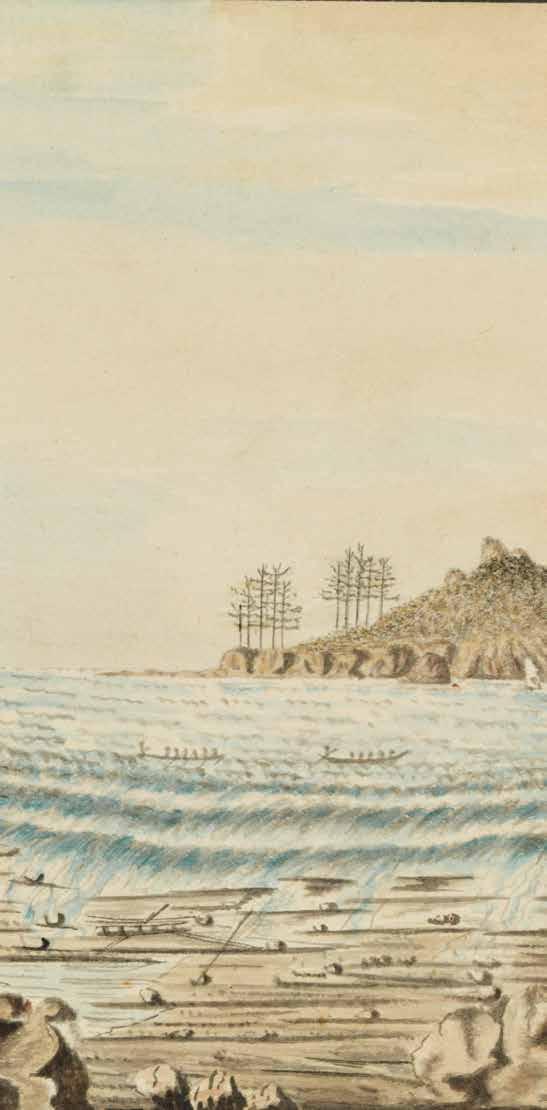
sOme 225 years after the first european settlement on norfolk island, first-time visitors get an idea of what it is like to live in such a remote location when they visit the island’s main supermarket. On a research visit in October 2013, i watched australian tourists roam the township’s supermarket aisles with bewilderment and, at times, dismay. Customers scanned expansive tracts of empty shelving and fridges that were punctuated with a narrow selection of packaged goods, clustered in their relevant sections on the shelves. some were disappointed by the lack of variety and choice, and many were shocked at the high cost of ordinary commodities. Dairy products and other perishables were particularly expensive, but even ‘weekly specials’ of packets of biscuits or breakfast cereal sold at double sydney supermarket prices; generic brands of rice and pasta were more expensive than gourmet labels back home. aghast at the lack of supplies, we were reassured by staff that a shipment was due on wednesday (it was then monday) and that there would be more on offer in the next few days, depending what the ship had aboard. t his might not help self-catering tourists who had only come for a few days, but the locals were abuzz with anticipation of the freighter’s arrival.
most of norfolk island’s consumer goods come from australia or new Zealand. Perishables are flown in on the weekly passenger planes from sydney (some 1670 kilometres away), Brisbane (1450 kilometres) and auckland (1060 kilometres).

The loss of Sirius left 500 First Fleet colonists and marines stranded on Norfolk Island with inadequate provisions for several long, isolated and hungry months
non-perishables arrive by freighter ship every four to six weeks, depending on the weather and conditions at sea. t his week’s shipment was the first for more than a month, hence the noticeable gaps on the supermarket shelves.
t he purpose of my visit to norfolk island had a definite food focus, but in a more historical sense: to research the island’s foodways in its early colonial period in the late 1700s.
t he island was settled as part of the British colonisation of new south wales in 1788, under l ieutenant Philip Gidley k ing. a lthough the settlement was razed when the island was abandoned in 1814, evidence of the first convict colony remains in the k ingston and a rthur’s vale h istorical a rea (kavha), which is now a world heritage listed precinct. t his is also the site where hms Sirius – flagship of the First Fleet that brought the founding group of european settlers to new south wales in 1788 – was wrecked in sydney Bay in march 1790. t he loss left the new south wales colonising effort without its ‘sheet anchor’, as Governor a rthur Phillip lamented, and stranded more than 500 First Fleet colonists and marines on norfolk island with inadequate provisions for several long, isolated and hungry months. a rtefacts from the wreck and the settlement area, some of which are displayed in the norfolk island museum (see article on page 46), have left tangible evidence of this period in the form of material culture, including food remains. echoes of this period and its food stories resound more broadly on the island, even in the present day, providing a strong link between the two sydneys – sydney Bay at norfolk island and sydney Cove on Port Jackson – and the foundation story of new south wales.
Due to the island’s remote location and rugged coastline, access has been a challenge for norfolk island’s inhabitants and administrators since the first days of european settlement. to this day, ships have to anchor a kilometre offshore and use a lighterage service into Cascade Bay or k ingston (on sydney Bay), depending on prevailing conditions. Cargo is unloaded by the ships’ derricks into 10-metre lighters, modelled on whaleboat chasers used in the early 1900s, which are then towed ashore by motorised launches. shipments can be delayed, with freighters sitting in frustratingly full view of islanders, until conditions permit access and unloading. l arge imports, such as cars, trucks or machinery, are loaded across two lighters in tandem. at k ingston the lighters are
strategically navigated between the reef and rocky shoreline at sydney Bay in much the same fashion that First Fleet colonists negotiated their way to shore in the late 18th century.
t he unloading process is quite a spectacle and the lighterage service is regarded as part of norfolk island’s unique cultural heritage. tourists gather along the shoreline at k ingston’s pier area to view the process, alongside locals awaiting their anticipated goods to be hoisted from the lighters onto the pier with the assistance of a small crane. witnessing the rigmarole involved in servicing the island with imported goods develops a deeper appreciation of norfolk island’s remote location. it highlights the tenuousness of island life and its reliance on the outside world for survival.
For the historian, it amplifies the difficulties endured in supporting and servicing the norfolk island settlements long before aviation, motorised boats and modern communication systems.
l ieutenant k ing’s journal describes the difficulties endured in finding an access point onto the island in 1788. Cascade Bay on the northern side of the island offered potential, with a natural ‘landing rock’ positioned some 300 metres from a stony beach. People could be ferried ashore from the landing rock, but transferring bulky stores proved more difficult. a fter five days exploring various possibilities, a narrow and intricate passage through the reef that runs along sydney Bay was discovered, providing access to the shore. t his passage remains the principal access way for sea-freighted goods and commercial fishing boats today.
t he first convict settlement, which k ing named sydney, was established between the foreshore and a rivulet that ran not far beyond (now known as a rthur’s vale). viewing the modern unloading process while sitting within the archaeological footprint of the first convict settlement develops a rich sense of place.
Drawings from the 1780s and ’90s take on renewed form and meaning; words from contemporaneous journals take on a physical perspective. visiting the pier area in less favourable conditions highlights the inherent dangers that seafarers face trying to access the island – rough swells crash against the reef and drive seas towards the rocky cliffs just west of the bay, rendering the only through-passage unnavigable, or at least highly dangerous. t his lesson was learned early in the island’s european history, with the loss of Sirius, but also at the cost of other vessels and many lives in the island’s colonial history.

01 Previous pages: Part of the reef and landing places in Sydney Bay, Norfolk Island, on which the Sirius was wrecked. 19 March 1790. From William Bradley’s journal A Voyage to New South Wales, 1802. State Library of NSW a3461022
02 Philip Gidley King was supervisor of the Norfolk Island settlement at the time of the wreck of the Sirius, and later became governor of New South Wales. ANMM Collection
03 A map in William Bradley’s journal. Bradley surveyed Norfolk island during the 11 months he was trapped there due to the wreck of the Sirius. State Library of NSW a138503
04 The Settlement on Norfolk Island, May 16th 1790, George Raper. A handwritten note on the back of the work says, ‘This view was taken after the wreck of H.M.S. Sirius when the settlement were at ¼ allowance’. The blue and yellow signal flag indicates safe conditions for landing. State Library of NSW a3164001 03


Shipments can be delayed, with freighters sitting in frustratingly full view of islanders, until conditions permit access and unloading
early colonists’ journals reveal the anguish endured as they witnessed, on more than one occasion, the loss of good seamen, convicts and children who fell victim to the short but perilous transfer from ship to shore in jolly boats or open coble fishing boats, which were built by colonists on the island.
In what was considered as good landing, one of the boats, in coming into the passage, was overtaken by a succession of heavy surfs, which threw her on one of the reefs, where she parted in less than two minutes, and seven people were drowned.
(Captain John hunter, august 1790)
t he loss of hms Sirius was norfolk island’s most famous and significant incident in the early convict period, and perhaps in the island’s maritime history. it can be argued (especially by a gastronomic historian) that food caused the demise of Sirius i n response to a looming food crisis, Sirius, under the command of Captain John hunter, had come to the island together with the Supply tender, the only other remaining First Fleet vessel to service new south wales, to deliver convicts and provisions from the ‘other’ sydney, in Port Jackson.
t he main colony in Port Jackson faced a critical food shortage as its dependent population of more than 800 struggled
to sustain itself on local and farmed produce, and replenishment supplies had failed to arrive from england as promised. i n an effort to alleviate pressure on that settlement’s resources, Governor a rthur Phillip sent 281 colonists to norfolk island, believing it could support a population greater than the 150 it had hosted until then. Despite difficulties with destructive storms, and pests and vermin attacking crops, k ing boasted ‘vegetables in the greatest abundance’, good harvests of grain and regular catches of fish and birdlife which offered further savings to the government stores. Sirius was then to return to Port Jackson to provision itself for a mercy dash to Canton to procure bulk provisions for the colony.
t he reef at sydney Bay put an end to that opportunity. a blue and yellow signal flag raised on the shoreline indicated safe conditions, and Sirius attempted to approach the island to offload its cargo in sydney Bay. But ‘ the wind freshened and the sea rose … she struck upon a reef of coral rocks which lies parallel to the shore, and in a few strokes was bulged’. (hunter, march 1790)
m iraculously, all aboard survived and most of the provisions the ship carried were landed ashore. eighty crew, including
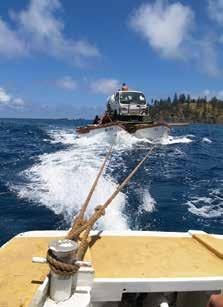

Captain hunter, were stranded on the island for many months, adding to the numbers of mouths to feed. with great frustration and in miserable circumstances, they remained until February 1791, when the Gorgon arrived to transport them to england. having witnessed Sirius ’ wrecking, k ing lamented his failure to have rendered Cascade Bay more serviceable, as ‘a good landing place may easily be made, where any thing might be landed from half ebb to half flood’ (k ing, march 1790).
Cultivation, rather than maritime access, had instead been k ing’s priority, with most of the labour force concentrated on clearing and preparing ground for food production.
Landing [at Cascade Bay] is much more oftener practicable than in Sydney-Bay; indeed I should have got this business done, but that it would have been a great hindrance to cultivation, which I ever thought was the principal object to attend to. (k ing, march 1790)
Paradoxically, the agricultural efforts that enabled norfolk island to be a solution to hunger cost the beleaguered colonies another lifeline, the flagship Sirius returning to sydney Cove with news of the catastrophe, where ‘dismay was painted
on every countenance’ (watkin tench, april 1790), Supply was sent on a mercy dash to Batavia to organise a shipment of stores, and to return in haste with emergency supplies. a s a consequence, both sydneys were left in isolation from each other and from the outside world for months to come, and suffered further hunger problems.
t he Sirius story remains powerful in norfolk island’s colonial and maritime history. t he Sirius museum and a memorial for the wreck stand on the k ingston foreshore, and relics and archaeology from the wreck offer a rare insight into the world of our past. But watching the unloading of a modern freighter, in view of the Sirius wreck site, helps develop a greater, more immediate narrative of everyday life in the early settlement of both sydneys, their reliance on maritime connections with the world, and the efforts involved to keep food on the table.
Sources and further reading
John Hunter (1737–1821), An Historical Journal of the Transactions at Port Jackson and Norfolk Island, 1793.
Philip Gidley King (1758–1808), The journal of [Philip Gidley] King, in Hunter, John, above.
01 Lighters alongside a freighter off Cascade Bay, ready to begin unloading. Courtesy Robin Nisbet Photography
02 Large cargo, such as vans, is loaded across two lighters, which are then towed to the pier. Courtesy Haylee Fields
03 Cargo is swung from lighter to pier in nets. Courtesy Robin Nisbet Photography
Watkin Tench (1759–1833), A Complete Account of the Settlement at Port Jackson, 1793. Historical Records of New South Wales 1:2 p 397. Norfolk Island Museum www.hmssirius.com.au/ flagship-of-the-first-fleet/shipwrecked.
Jacqui Newling is Sydney Living Museums’ resident gastronomer and Assistant Curator, Interpretation and Exhibitions. She is a postgraduate candidate in history at Sydney University, and her research trip to Norfolk Island was made possible with funding awarded through the James Kentley Memorial scholarship from the University of Sydney.
Norfolk Island’s inaugural Food Festival will be held from 22 to 29 November 2014. The festival is a celebration of Norfolk’s fresh, seasonal produce that comes from paddock to plate – no food miles! Due to the island’s strict quarantine laws all produce is grown locally (except onion, ginger and garlic), so local chefs are used to cooking with what’s in season.
‘Fast Ed’ Halmagyi and Dominique Rizzo are guest chefs for the week. For further information visit norfolkislandfoodfestival.com

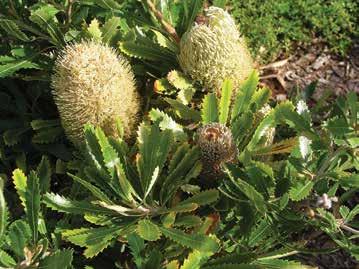
The fact that so many collections made it back to England in a reasonable condition is extraordinary
The artists and botanists who joined James Cook aboard HMB Endeavour on his first expedition into the Pacific made hundreds of drawings and sketches of the exotic flora they encountered. Louisa Murray of the Royal Botanic Gardens, Sydney, discusses their work, which resulted in a multi-volume botanical masterwork more than two centuries in the making.
when hm B ENDEAVOUR left Plymouth harbour in england with l ieutenant James Cook at the helm on 26 august 1768, on board were some 94 men, their supplies and equipment, ten carriage guns, livestock for meat, plus a party of naturalists with a huge amount of gear – their personal possessions and all the paraphernalia needed to preserve and record the natural world which they would encounter.
t hey were on a voyage of scientific and geographic discovery. t he main aim was to chart and explore the Pacific Ocean and to observe and record the transit of venus across the sun in april 1769 from tahiti.
t hey were also charged with charting the coastlines of the islands visited in the south Pacific and taking detailed scientific observations about the land, its flora and fauna and the local i ndigenous peoples.
t he final – and secret – aim of the expedition was for Cook to locate and claim the rumoured Great south l and. nearly two years later, in april 1770, about 10 kilometres south of what is now sydney harbour, Endeavour anchored in a broad expanse of water and the first europeans landed on the east coast of what
would become known as australia. During their eight-day visit, the naturalists on board encountered an unusually large number of previously unknown plants. a fter first choosing the name stingray Bay, Cook later changed it to Botany Bay in recognition of this new and impressive flora.
On board Endeavour were Charles Green, chosen as the royal society’s observer astronomer, and Joseph Banks, also of the royal society, who was both naturalist and benefactor of the voyage. to accompany him, Banks had selected the swedish naturalists Daniel solander and herman sporing and the artists sydney Parkinson and a lexander Buchan. t he ship’s Great Cabin was the working room for the men of science and Cook himself.
when we stand in the Great Cabin of the replica hm B Endeavour today, and consider that in this space all these men ate and worked – the naturalists processing specimens, the artists drawing and painting, and Cook charting the coasts – it seems remarkable that they managed to bring back so many specimens, pictures, charts and maps in good condition. keeping the specimens dry must have been very difficult
Collecting plant specimens for scientific research is very much the same now as it was on Endeavour in 1770
from other parts of the world. t hey use newspaper and cardboard to enclose the plant specimens in a large plant press, which is then put into a drying room to speed up the process of preservation. t he collections are then sorted into their species and housed in plastic boxes on many rows of shelving in a building called the herbarium. t hey are shelved in order of how we think the plants would have evolved on earth. t he study of plants is continual; not only are humans yet to collect many of the world’s plants, but also we are still studying the plants themselves, how they exist in their environments, and the relationships among them.
a nimal specimens were also collected on the Endeavour, sometimes sealed inside a jar of alcohol but more usually eaten and then the skins, bones and feathers dried out and kept dry. t he expedition also made collections of shells and of artefacts from the i ndigenous communities they encountered. most of these are in l ondon’s natural h istory museum.
Banks intended to issue 14 folio volumes of his natural history discoveries. at a total cost to himself of about £10,000, he employed five watercolourists from the winter of 1773 to complete 595 new artworks based on Parkinson’s unfinished work. he then employed 18 engravers until 1784 to cut copper printing plates, based on 743 artworks, in readiness for scientific publication in colour. t hese 743 copper plates were subsequently engraved, with the intention of Banks publishing and suitably illustrating his scientific results from the voyage. t his never happened in Banks’ lifetime.
not until between 1980 and 1990 were 100 copies of the 35-part a lecto h istorical editions finally printed in association with the British museum (natural h istory). t he royal Botanic Gardens in sydney and the state l ibrary of new south wales both have a copy of Banks’ Florilegium
on board such a small ship with water continually all around, and the ship not necessarily waterproof during the voyage. t he fact that so many collections made it back to england in a reasonable condition is extraordinary.
we know the processes of preservation of such specimens, as botanists today still collect and preserve natural specimens in the same way. with flora specimens, a small branch is collected then pressed and dried between papers. Endeavour carried quires of paper for this purpose – a quire being a collection of paper, folded one sheet within the other in a manuscript or book. a n entry from Banks’ journal describes drying the specimens:
Our collection of plants has now grown so immensly large that it was necessary that some extraordinary care should be taken of them least they should spoil in the books. I therefore devoted this day to that business and carried all the drying paper, near 200 Quires of which the larger part was full, ashore and spreading them upon a sail in the sun kept them in this manner exposd the whole day, often turning the Quires in which were plants inside out.
[3 may, Botany Bay]
today botanists at the royal Botanic Gardens in sydney still collect plants, mainly from all over australia but also
t he artists recorded the landscapes, flora and fauna, and i ndigenous peoples they met along the way. a lexander Buchan’s paintings and drawings, now mostly held at the British l ibrary in l ondon, depict only scenes and animals encountered during the outward voyage. Banks recorded in his journal that Buchan suffered from an epileptic seizure and died on 17 april 1769. he was buried at sea without ever seeing the shores of the ‘Great south l and’.
sydney Parkinson made extraordinary botanical paintings of the new species collected on the voyage. Buchan’s death left Parkinson as the sole artist for the rest of the voyage, and such great numbers of plants were collected that to keep pace with the two botanists, Parkinson resorted to making brief outline drawings of the plants, with specific areas partly coloured in so that they could be finished later. Characteristics about the plant and the colours were also noted by Banks and solander. t he art works eventually made up 21 large bound volumes. Parkinson is estimated to have generated 955 drawings on the voyage – 675 sketches and 280 finished drawings. Unfortunately sydney Parkinson died of dysentery on the return trip, along with Charles Green, herman sporing and other members of Cook’s crew. t here had been virtually no disease on board the ship until Cook reached Batavia (now Jakarta) on 10 October 1770. malaria and dysentery were rife there and they spread among the crew very quickly.
On the voyage, Banks and solander collected approximately 110 new genera and 1,300 new species. at Botany Bay alone they collected 132 species. when these plant specimens returned to england they were kept in Banks’ house in l ondon, where solander worked on them. l ater those specimens were studied by robert Brown, a botanist engaged by Banks to return to australia in 1801. he arrived in 1802 aboard the Investigator with matthew Flinders. Banks left his specimens and papers to robert Brown in trust and after Brown’s death they were transferred to the British museum (natural h istory). t he collection of specimens still remains there, but since 1932 the British museum has returned to australia specimens containing duplicate or excess material of the species collected on the east coast. t hese are now housed at the herbarium at the royal Botanic Gardens, sydney. Other collections were later sent from Britain to other herbaria in australia. a ll these years later these specimens are still used in botanical research, and are surprisingly similar in condition to modern-day specimens.
i n the last two years the australian national maritime museum has welcomed botanists from the royal Botanic Gardens and Domain trust for national science week on board the hm B Endeavour replica. t here, in the Great Cabin, they explain the use of the plant species by the aboriginal tribes who lived around the Botany Bay area (see box on page 32), and conduct workshops and information sessions for primary school children and the public.

01 Page 28: Banksia serrata, plate 285, Banks’ Florilegium. Lithograph engraved by Gabriel Smith from Sydney Parkinson’s drawing of a specimen collected at Botany Bay in 1770. ANMM Collection Gift from Dr Eric and Mrs Margaret Schiller
02 Page 29: Banksia serrata growing at Kamay National Park, Sydney, today. Courtesy Royal Botanic Gardens, Sydney
03 A self-portrait by Sydney Parkinson, who died in his mid-20s but left a legacy of hundreds of botanical illustrations and sketches. Courtesy Natural History Museum, London
04 Kennedia rubicunda, plate 74, Banks’ Florilegium. Lithograph engraved by D Mackenzie from Sydney Parkinson’s drawing of a specimen collected at Botany Bay in 1770. ANMM Collection Gift from Dr Eric and Mrs Margaret Schiller

All these years later the specimens collected on Cook’s first voyage are still used in botanical research

t hey demonstrate how collecting plant specimens for scientific research is very much the same now as it was for Banks and solander on board ship in Botany Bay in 1770. visitors examine specimens of the same plant species collected by Banks and solander and children can take away their own herbarium specimen.
Other hands-on science activities involve measuring the ship’s speed using a knotted line trailed over the stern, collecting microscopic life from the waters of sydney harbour then examining it under a microscope and noting the findings, and learning about mechanical advantage by the use of blocks and pulleys. holding these sessions in the evocative environment of Endeavour helps to show students the strong link between past and present scientific practices and the role that this ship played in the study of our world.
Florilegium specimens, drawings and lithographs can be seen at the National Museum Australia’s webpage: nma.gov.au/av/flash/voyages/science_ florilegium.html
Reference for collecting plants
rbgsyd.nsw.gov.au/science/Herbarium_and_ resources/nsw_herbarium/processing_plant_ specimens/Preserving_plant_specimens
D Benson and G Eldershaw (2007), Backdrop to encounter: the 1770 landscape of Botany Bay, the plants collected by Banks and Solander and rehabilitation of natural vegetation at Kurnell Cunninghamia 10(1) pp 113–137.
rbgsyd.nsw.gov.au/science/Evolutionary_ Ecology_Research/Botany_of_Botany_Bay
In 1770, the land on which the Europeans set foot belonged to the Dharawal people. The Aboriginal tribes around the Botany Bay area were the Kameygal, Gweagal and Muru-ora-dial people. Banks described the Aboriginal inhabitants in his journal when writing about coming into Botany Bay:
At 1 we came to an anchor abreast of a small village consisting of about 6 or 8 houses. Soon after this an old woman followd by three children came out of the wood; she carried several peice[s] of stick and the children also had their little burthens; when she came to the houses 3 more younger children came out of one of them to meet her. She often lookd at the ship but expressd neither surprize nor concern. Soon after this she lighted a fire and the four Canoes came in from fishing; the people landed, hauld up their boats and began to dress their dinner to all appearance totaly unmovd at us, tho we were within a little more than a mile of them. Of all these people we had seen so distinctly through our glasses we had not been able to observe the least signs of Cloathing: myself to the best of my judgement plainly discernd that the woman did not copy our mother Eve even in the fig leaf.
Later when the ship was to anchor for them to come ashore and look for water, they were met by the Aboriginal men with four-pronged spears (lances) which they used daily in fishing.
The Aborigines’ survival in this unique new environment must have intrigued those on board Endeavour Animals and seafood were obviously in plentiful supply, but there was also a plant that they used as a vegetable, now called Botany Bay spinach or warrigal greens (Tetragonia tetragonioides), which, when cooked, looks and tastes like spinach.
On the same site where the British settlers established their first farm in 1788, Sydney’s Royal Botanic Gardens has a garden called The First Farm and Cadi Jam Ora: First Encounters. A storyboard relates the history of the Aboriginal people before and after the arrival of the British fleet in 1788. Half the population of Aborigines around Sydney succumbed to smallpox within a year of the fleet’s arrival. As the colony expanded, Aboriginal people were displaced and subjected to acts of aggression. Their traditions and way of life became impossible to keep. It is only in recent times that acknowledgement of Aboriginal country has become part of daily life for the wider Australian community. Aboriginal use of plants is still being documented by researchers today. The garden is there to remind us that the land was occupied before the British colony was established. Cultivation and culture
01 Botany Bay spinach, also known as warrigal greens ( Tetragonia tetragonioides). Courtesy Royal Botanic Gardens, Sydney
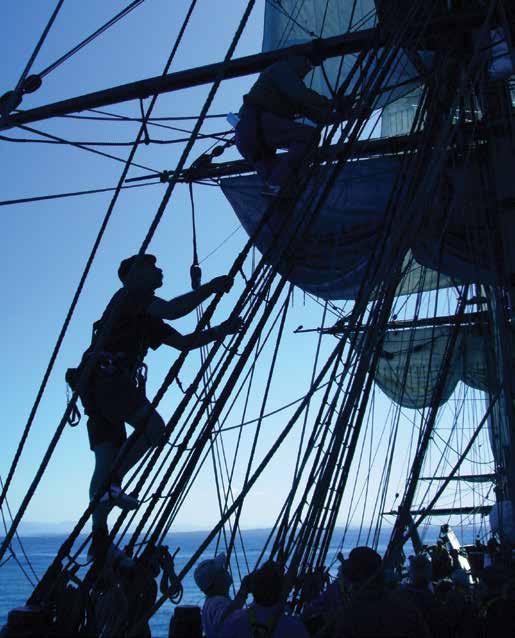



This is your chance to be part of a living maritime tradition and learn to sail the square-rigged HMB Endeavour replica.
You will learn how to set and hand in sail, keep watch, climb aloft, navigate by planning a passage and take the helm.
Ideal for anyone with a sense of adventure and a taste for history.
Embark on a life-changing adventure for as little as $275 per day!
1–5 September
Sydney and pittwater
Introduction to sailing, covering the fundamentals of square rig sailing.
8–12 September
Sydney – pittwater – Newcastle
Includes an introduction to the basics of botany, from collecting specimens to scientific drawing.
17–21 September
Newcastle – port Stephens – Sydney
Featuring a demonstration on how to navigate by sextant and lectures with a guest astronomer.
Also available
21 October – 7 November eden voyages
28 January – 6 march 2015 Hobart voyages
Spaces are strictly limited
bookings
Endeavour Voyage Coordinator
hmbendeavour@anmm.gov.au
Phone 02 9298 3627


01 The finished bronze sculpture of Matthew Flinders. The text is a draft for the finished inscription that encircles the figure. All images courtesy Mark Richards
A statue recently unveiled in London commemorates Matthew Flinders, the distinguished navigator who popularised the name ‘Australia’, charted vast tracts of its coast and was the first to circumnavigate the continent. Its sculptor, Mark Richards, explains how the statue was conceived and created.
t he m atthew Flin Ders memorial statue is the brainchild of Peter a shley rn (rtd), whose interest in Flinders and his story was first piqued by a statue outside st Paul’s Cathedral in melbourne. i nspired, the former naval weapons systems engineer went on to write a dissertation on this remarkable man as part of an ma in maritime history. t his was followed by a book1 and an international lecture tour.
i n 2011, Peter conceived the idea of a statue for the United k ingdom, to be completed and installed in time for the bicentenary of Flinders’ death on 19 July 2014.
t he work was officially commissioned by the government of south australia, and a steering committee, chaired by John a llen, was convened with representatives from australia and the U k network r ail was keen to locate the statue at euston station in l ondon, site of the former st James’ Cemetery, where Flinders is buried. i was asked by the committee to present some ideas for a statue in this location. i began my research in march 2013 and presented my initial designs in the following may.
Given that matthew Flinders is largely unknown in the U k (i for one knew the name but not much more), i set out to create a work that explained who he was and what he did. t he statue was to be as much an introduction as a commemoration. while reading and discussing Flinders i was, of course, struck by his symbolic status as representing the grand ambitions of king and country. i was also intrigued, and at times horrified, by the day-to-day reality of his seafaring life: the discipline, organisation, unimaginable privations and determination required to cope with the demands on body and spirit. a side from being shipwrecked, starved and attacked
at various times while charting the coast of australia, Flinders pursued a rigorous and monotonous daily routine for months. t he now-famous map progressed at a snail’s pace and with extraordinary accuracy.
i have travelled in australia and have a brother who is a citizen there. a mong the many aspects i liked about the australians was the absence of stifling formality and opaque under-currents. People were pretty straight with me. moreover, i found that taking the initiative was held in high regard. with all this in mind, i wanted to present Flinders not as a distant heroic figure, but as a man among us, in resonance with the australia i had experienced.
to familiarise myself with the commission and the project’s desired outcome, i talked a great deal with Peter a shley and the committee. i then began reading whatever was available and built up, in my mind’s eye, an image of matthew Flinders and a clear idea of his character and achievements.
my technique when planning a statue like this is to wander the site for a while and imagine what might work in the space. i then free-draw a lot and the idea coalesces into more detailed drawings until i arrive at something i am happy with.
From the drawings i make a quarter-lifesize maquette – a three-dimensional ‘sketch’ used by sculptors to develop ideas in the round from the drawings. most of the major decisions about content, composition and emotional dimensions are made at this stage.
single-figure statues are often composed and sited with an architectural element behind them, which encourages the work to be experienced from a restricted viewpoint, typically the front of a figure. t his visual constraint might be underscored with a title inscription on the leading face of a plinth.
Given that the matthew Flinders sculpture was to be located in a public space and would be seen from 360 degrees, i wanted to work out a single-figure composition without one dominant aspect. to this end, i ditched my first impulse to portray him standing and wrestled him down into a wider, bell-tent composition. t his helps prevent there being a dominant ‘front’ to the sculpture. From every angle you can glimpse visual possibilities in other areas and so the viewer is encouraged to encircle the piece. Flinders’ faithful ship’s cat, trim, creates another layer of visual interest.
i also found that bringing the figure from a standing to a crouching position made the statue feel more accessible. i liked this development and took it further by conjoining the plinth with the content of the sculpture, centring the composition about the focus of his charting work.
I wanted to present Flinders not as a distant heroic figure, but as a man among us, in resonance with the Australia I had experienced
Flinders is holding the points of a compass to an outline of the australian coast. t he outline, which corresponds to the original Flinders map, is etched into the top surface of the plinth. From the array of possible mapping instruments, i chose a compass as it made reference to the magnificent statue of newton based on a painting by william Blake2 in the courtyard of euston’s neighbour the British l ibrary,
thereby underlining the statue’s sense of place. l evelling Flinders’ head with that of an adult viewer further enhances the informal character of the sculpture and invites close inspection of his activity.
On the maquette, the etched map encircles Flinders: this worked on a small scale, but was unreadable once the maquette was enlarged to full size. For that reason i reduced the relative size of the map on the finished work so that it can be taken in at a glance; it is instantly recognisable as the outline of australia. a further development from the maquette is the compass contact points on the coastline. at maquette stage, i determined where the points and outline met solely by virtue of making the design of the map fit around the figure. i n the final work, a fact finds its way in as the front compass point touches the location of Port l eeuwin, where Flinders began his exploration of the ‘unknown coast’3 and circumnavigation of the continent.
t he particulars of the figure show Flinders out of official uniform and absorbed in his work. without the viewer having any prior knowledge of Flinders and before reading the inscription, the composition already suggests a great deal about him. he is mapping. he is working on the ground rather than at a table, which suggests that he is outside. he is measuring on a map, which indicates the task at hand, and the telescope at his right knee implies a naval connection. h is stance hints at the kind of chap i felt him to be: steadfast, determined, focused and possibly a tad diffident.
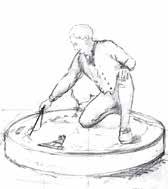

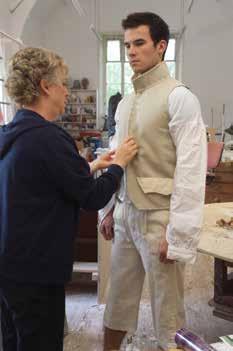

01 One of the preliminary drawings for the statue.
02 Maquette, bronze, 30 x 34 x 34 cm.
03 Costume designer Elizabeth Gurney fitting a mocked-up 18th-century navy uniform to model Robert Doyle.
04 The full-size clay in progress with the lay figure in the background.
05 Prince William and Mark Richards discussing the statue at the unveiling ceremony at Australia House, London, on 18 July 2014. 05
Once i was happy with the composition of my maquette, i began the full-size piece. t he full progress of this can be seen in a blog – flindersstatue.blogspot.co.uk – but here i will touch on the importance of a couple of aspects: drapery and scale. i nevitably, the work matures through the process of enlargement; details in the hang and movement of clothing are exaggerated and so need greater attention and fresh reference. to this end, i made a life-size lay figure (the name is derived from the Dutch ‘led’, meaning limb – essentially a customised mannequin on which the drapery can be set for reference) and fed the resulting insights into my enlargement.
a s objects, we humans are surprisingly small when stilled and isolated in space. to make a figure sculpture appear lifesize in a public arena, as a rule of thumb you have to make its dimensions at least a quarter larger than life (increasing, incidentally, the volume by around 60 per cent).
a mong the numerous joys of this commission has been that of working with the australian h igh Commission here in l ondon, and the matthew Flinders memorial statue Committee. i have had their unstinting support throughout the creation of the work, and they have brought to bear their collective wealth of experience and ability to make the project a huge success.
a n early example of a group endeavour was to address the possible inference that matthew Flinders and his contemporaries had ‘discovered’ australia. we did not wish to dilute Flinders’ achievements; neither did
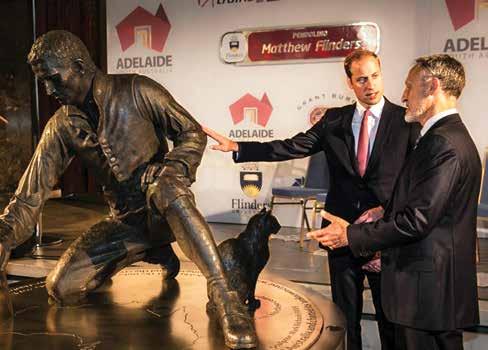
we want to overlook the 70 or so thousand years of sophisticated i ndigenous culture that existed in the continent prior to european settlement. t herefore, after much consultation with relevant parties, we settled upon a reference to Flinders’ personal and, by all accounts, close relationship with his aboriginal guide and friend, Bungaree. it is an aspect of the story that Prince william made particular reference to in his unveiling speech. t he words ‘unknown coast’ are in parentheses in recognition that the coast was not unknown to its inhabitants.
The Matthew Flinders memorial statue has been financed primarily through the sale of maquettes and no public money has been spent
renowned letter designer John neilson created the inscription around the perimeter of the circular base. John is currently generating a font based on the inscription which is called Flinders sans.
t he matthew Flinders memorial statue has been financed primarily through the sale of maquettes and no public money has been spent. at the outset of the commission, i ‘published’ (or made available a certain number for purchase) an edition of
75 signed and numbered bronze maquettes. t he edition has been extremely popular – so much so that it has generated a surplus which is being used as seed-funding for a scholarship from Flinders University to enable an exchange program between australian and British students.
t he full-size statue was unveiled by Prince william, the Duke of Cambridge, at australia house, l ondon, on 18 July 2014. t he ceremony was a moving occasion attended by supporters of matthew Flinders and the statue project from around the world. a fter the ceremony, the work was moved to the concourse of euston station and opened to the public on the following day, 19 July, the bicentenary of matthew Flinders’ death.
Notes
1 The Indomitable Captain Matthew Flinders Royal Navy, Peter Ashley, Pierhead Press 2005.
2 Newton after Blake by Eduardo Paolozzi, 1995.
3 The Great Race, David Hill, Heinemann 2012.
At the time of writing, there are 15 maquettes remaining in the edition. Purchases are being handled by the Australian High Commission in London. Details of the edition can be found at flindersstatue.blogspot.co.uk or by contacting the Agent General’s office on +44 (0)20 7520 9111 or emailing Matt.Johnson@south-aus.eu
Born in 1958, Mark Richards is a sculptor based in the UK. He welcomes challenging commissions from around the world and particularly enjoys creating sculpture for projects and spaces. Mark can be contacted through his website, markrichards.eu

01 Lesley Walker with the Charles W Morgan at the end of the voyage to New Bedford. All photographs courtesy Lesley Walker unless otherwise stated
02 Charles W Morgan coming alongside the State Pier, New Bedford. Photo courtesy Annette Mason
SAILING ON THE ChArlEs W MorgAn ’S 38TH VOyAGE
America’s last wooden whaling ship, the Charles W Morgan, recently made its first voyage since 1921, after a five-year, multi-million-dollar restoration. Former ANMM staff member Lesley Walker has a family connection to the ship, and was one of those chosen to sail aboard it as it returned to its home port of New Bedford, Massachusetts.
i t was a hOmeCOminG more than 70 years in the making. at 1430 on 25 June 2014 new Bedford appeared in the distance. a lmost as if it had sensed this long before, the Charles W Morgan was flying at eight knots under nearly all sails, heading across Buzzards Bay towards its home port for the first time in 73 years. But it was moving too quickly, so at 1520 the slowing down process started: the main yards were backed, fore and main yard squared and braced up and then the tow line passed to waiting Sirius, the fore topsail braced in, the jib taken in, the inner and upper topsails lowered. t he ship approached the hurricane gates, still wearing its lower topsails and accompanied by a flotilla of more than 40 boats and a local press helicopter. Crowds of people lined the two shores as we heard a sudden boom and saw the smoke rising from the cannon fired in welcome from Fort Phoenix on our starboard side. t he ship was coming home. in many ways, though this was not the end of the voyage, it was the culmination of the five-year restoration of the last wooden a merican whaling ship. Built at hillman’s shipyard and launched in new Bedford
on 21 July 1841, this ship is the only survivor of about 270 whaling ships that sailed the world from new Bedford, massachusetts, which by 1839 had overtaken nantucket as a merica’s leading port. t hough the whaling industry peaked in 1859 the Charles W Morgan kept whaling, for a time to the a rctic from a base in san Francisco, then back to new Bedford, its final brief whaling voyage ending in may 1921.
rescued from being scrapped like so much of the fleet, from 1926 it became a museum exhibit on the estate of Colonel edward Green at Dartmouth, massachusetts, where it was visited by more than two million people. But on his death in 1936 it was discovered Green had not made any provision for the ship’s future. Faced with inevitable deterioration and, despite huge local efforts, unable to raise the necessary funds, the trustees reluctantly agreed to hand over the ship to mystic, Connecticut, a decision that has troubled new Bedford ever since. On 6 november 1941 it was towed into the mystic r iver, where it has remained as part of mystic seaport museum until the decision was made for it to go to sea once again on its historic 38th voyage.
my part in this story began when i read about the proposed 38th voyage in the December 2013 issue of the U k’s Classic Boat magazine and sent off an application to join it. i was in sydney in march this year when the email came offering me a place. i had just restarted what i call my ‘south Pacific project’, from which i hope a book will come, and this was an opportunity too good to miss. my great-great-grandparents had sailed from new Zealand to the kermadec islands via tonga and samoa in the late 1870s and, with their six small children, literally beached themselves on the uninhabited volcanic island known as sunday or r aoul island, some 1,450 kilometres north-east of new Zealand. my great-grandmother Bessie, then aged 9, was the second-eldest and five more were born on the island, of whom four survived. From the start they were beset by problems.
a s the coastal trader Norval sailed away, they discovered that the food supplies they had bought from the ship’s captain to see them through the first year were ruined; mouldy, inedible and bad. Poor weather followed and a plague of rats which ate everything they planted. a year after their

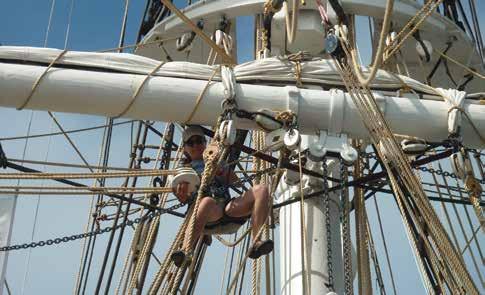
arrival, they were in dire straits when an a merican whaleship, the Canton – sister ship to the Charles W Morgan – saw their smoke and sent a whaleboat ashore to investigate. what the Canton found is recorded in the log on 11 July 1879: ‘when we got in quite handy, we discovered smoke and a signal as though someone was in distress. Lowered a boat and went inshore but could not get near enough to hail them on account of the heavy sea and heavy gusts of wind coming from off the mountain. We lay off and on until dark ... There appeared to be five or six persons ...’.
Due to bad weather it was another four days before the ship could again approach the island:
We worked up to ‘Sunday Island’ again at 3pm and found the people there are a family named ‘Bell’, Mr & Mrs Bell & six children in destitute circumstances, their crops having been destroyed by rats.
t he following day the crew gave them bread, flour and ‘a few small articles from the crew to the people ashore’. a few months later, at norfolk island in December, Canton shipped six new hands, including Parkins Christian as fourth (later third) mate. more than 130 years later i would board, sleep, explore and sail on one of the whaling ships that sailed and whaled off the island and that my great-grandmother recalled in her memoirs. it was also the ship on which Parkins Christian, one of her family’s long-standing friends, served as first and second mate for 25 years. During my training visit to mystic seaport, Connecticut, in april and after the voyage in June, i would also have the chance to explore
the log books in the collections of mystic seaport museum and the whaling l ibrary in new Bedford. Of the 79 voyagers, i was the only australian. t he only other nona mericans were also women: a British artist from l ondon and two new Zealanders, an historian and natural history film maker from Dunedin and the curator of the whaling museum at Butler Point, mangonui.
The new president of the Mystic Seaport Museum posed the question, ‘What would it take for the Charles W Morgan to sail again?’, and thus a vision started to take shape
t he 38th voyagers were invited to attend a training day in april at mystic seaport museum: an opportunity to meet the staff, get to know the ship and the collection, row a whaleboat, climb the rigging and find out about the visionary project to take the ship to sea once more. ever since it retired from whaling in 1921 after 37 voyages, it had been a static exhibit, first near new Bedford and, from 1941, at mystic seaport museum. t he museum’s policy was that the ‘Charles W Morgan will never sail again’. But during planning for a major restoration project the new president of the museum, steve white, posed the question, ‘what would it take for the Charles W Morgan to sail again?’,
and thus a vision started to take shape. Five years and $Us7.5 million dollars later, the 38th voyage was a reality. a major grant from the national endowment for the humanities made possible the 38th voyagers’ public history program, enabling the museum to invite people from a range of disciplines to participate in the story and contribute to the interpretation of the 38th voyage. i was one of those 79 people.
On 24 June, after a few hours in the martha’s vineyard library with two other 38th voyagers reading the very first of the Charles W Morgan’s log books with its beautifully illustrated pages, i boarded the bus for vineyard haven to join the ship.
t he dockside activities organised by the museum’s education department were still in full swing when i arrived: demonstrations of cooperage, shipsmithing, rope making, whaleboat rowing and knot tying; looking at samples of wood used in the restoration; searching the crew lists; live performances; an exhibition and video about the ship, the restoration, whaling and the voyage; and children’s activities.
i met other 38th voyagers and we shared our stories and projects, then after a barbecue and beer, we were ready to board. we were to sleep in the fo’c’sle along with some of the crew, and after selecting our narrow berths and stowing our bags, we went back up on deck for a safety briefing from the 3rd mate roxanne ‘rocky’ hadler and a tour of the ship. we were then at liberty until lights out at 2200. a s night came in i listened to mystic seaport’s chantey-man Geoff k aufman singing sea shanties and playing the accordion and a haunting bamboo nose flute from hawaii.


too excited to sleep, and with the 21stcentury fan in the fo’c’sle noisy and cold, i went on deck at dawn and watched the sun rise over the bowsprit. a lone except for the watch, this was a special moment to savour the peace and reflect on the day to come. By 7 am all was bustle and activity as the voyagers ate breakfast and the crew started to prepare the ship for sea. we met the guests who would be joining us for the day, including the president of mystic seaport and his wife, the mayor of new Bedford and the editor of the new Bedford newspaper. suddenly the ship seemed very crowded! t he two tug boats, Sirius and Jaguar, moved into position as we were allocated a watch and went through another safety and fire drill.
at 930 the lines were let go and the ship started to move slowly away from tisbury wharf assisted by one of the tugs alongside and a rigid inflatable boat at the stern. it was cloudy with fair visibility, south-west winds at 17 knots, gusting 20 to 23 knots. a s foresails were hauled up then lowered again, the ship’s 22nd captain, r ichard ‘k ip’ Files, explained that he had intended to try sailing off and tacking down vineyard sound but a strong 3-knot tide meant a tow was necessary unless we waited for the tide to turn.
stay sails were raised to help pick up speed, the crew taking their rhythm from shanties as they hauled on the halyards and walked them along deck. Geoff told us that halyard shanties were not necessarily used on whaling ships as they mostly sailed with enough crew to manage the sails. at 1130, still under tow down vineyard sound, it was decided to go through Quick’s hole
between nashawena and Pasque islands rather than around Cuttyhunk island, the original planned route.
Once through Quick’s hole at 1200 we broke the tow and we were sailing. starting with inner and outer foresails, mizzen and main stay sails and two mainsails raised, then the top gallants, we heeled over as the sails filled. it’s hard to describe the sensation of this – standing on the deck feeling the ship lift as we sailed across Buzzards Bay in a series of tacks, at one point reaching 8 knots. i wondered how Parkins Christian had felt as he approached his adopted home when yet another whaling voyage was ending. a fter serving on the new Bedford whalers Canton and California, he had joined the Charles W Morgan in 1893 and remained on it until 1913. i n 1916 the Boston Herald described him as a ‘disappointed man’ when he returned from a summer whaling cruise on the schooner A M Nicholson, which he had joined after learning the Charles W Morgan would not be sent out that year. On his return he discovered that in fact the ship had just left new Bedford for Cape Desolation in Greenland in search of ‘sea elephants’ (elephant seals). he said that if he had seen it on the whaling grounds he would have deserted the schooner to go to ‘my old love, even if i have to swim for it’. a s i felt the ship move through the water i could quite understand his feelings. i too will always cherish my short time sailing on the Charles W Morgan
a s the ship gently approached the state Pier in new Bedford and completed this leg of its historic 38th voyage, i had very mixed feelings of both elation and sadness. i was
01 A crew member aloft in the rigging. Half the crew on the 38th voyage were female.
02 The foc’s’le.
03 Dawn breaking over the bowsprit and jib boom, Vineyard Haven.
now one of a very few people alive who had sailed on an a merican wooden whaling ship. i had climbed the rigging twice during the voyage, savouring the sheer joy of being aloft on the main mast as the ship sailed. i had spent the night in the fo’c’sle, listening to the sounds of the ship, the sleeping crew and the watch on deck and feeling the barely perceptible movements of the ship in the water. i had hauled halyards and freed off lines, hung over the bow seeing the keel slice through the water and watched the sun rise over the bowsprit. a nd now it was time to leave. For the next few days the ship belonged again to new Bedford.
a few days later at the opening ceremony on the state Pier, steve white, mystic seaport’s president, said that the Charles W Morgan was not the museum’s ship, nor new Bedford’s ship, but ‘a merica’s ship. we undertake this voyage to teach and to help a merica understand its maritime heritage more fully ...’. i would add that, having crossed three oceans, connecting many worlds and peoples, and served by crews of many cultures, it is the world’s ship too.
Currently working as a heritage consultant in the United Kingdom, Lesley Walker is from Sydney. Head of Learning at the Historic Houses Trust of New South Wales (now Sydney Living Museums) until 1995, Lesley also worked in Public Programs and Visitor Services at the Australian National Maritime Museum in 2002 and 2003 when completing her PhD in migration history. As well as sailing on a classic 1937 Harrison Butler-designed wooden yacht and a more contemporary Contest 48 ketch, Lesley now lives on a 1938 Thames tugboat berthed in Woodbridge, Suffolk. Her project blogs on the Charles W Morgan can be followed on lesleybw.wordpress.com.
Corroboree Sydney is a new way of celebrating Australia’s rich cultural heritage, writes Hetti Perkins. Over 11 days and nights in November, leading Aboriginal and Torres Strait Islander artists, writers, dancers and musicians will showcase their creativity and share their stories in more than 100 events.
PresenteD at siGni F iC ant sites around sydney harbour, including the australian national maritime museum, Corroboree sydney offers a unique experience of i ndigenous culture. a national festival for all australians, it celebrates aboriginal and torres strait islander culture in the heart of sydney. t he event is initiated and delivered by i ndigenous people, for i ndigenous people and the wider community. t his collaborative endeavour will present a world-class festival that celebrates our culture in all its diversity.
a n eora word that has become part of australia’s identity, ‘corroboree’ means a place of ceremony and creative expression; a transformative gathering. For countless generations, the eora nations have been coming together to celebrate culture, country and community. Corroboree sydney continues this tradition on Gadigal land, sharing stories from the past and present, while embracing the cultural diversity that is i ndigenous australia.
Corroboree sydney brings together a program of activities for the discovery, participation and enjoyment of all. sydney’s premier arts and cultural organisations are collaborating to present talks, exhibitions, performances, live music, films, readings and forums.
i n 2014, Corroboree sydney will again present its signature events – the Firelight Ceremony and Opening Party, the Gurung Parade down macquarie street which involves more than 2,000 schoolchildren, elders’ Circles and the Black a rts market featuring work from over 30 new south wales aboriginal artists.
Corroboree sydney 2014 begins with a contemporary public ceremonial performance on the ‘apron’ forecourt of the museum of Contemporary a rt, drawing on the emerging talents from the Bangarra Dance t heatre australia, and follows the harbour to the australian museum at hyde Park. On the way it takes in the australian national maritime museum,

museum of Contemporary a rt australia, Blackfella Films, sydney Opera house, sydney harbour Foreshore authority, royal Botanic Gardens, koori r adio 93.7Fm, state l ibrary of new south wales and the a rt Gallery of new south wales.
t his year’s event will see many highlights, including the ‘sea Country’ exhibition at the australian museum; ‘homeground’, a curated dance and music weekend on the western boardwalk of the sydney Opera house; programs and workshops with the visiting Director of the i ndigenous Film retrospective from the sundance i nstitute; and a new venue, t he Boatshed, which will showcase emerging artists curated by koori r adio.
Corroboree Sydney runs from 20–30 November 2014. For more information, see corroboreesydney.com.au
01 Charles (Chikka) Madden and the NSW Public Schools Aboriginal Dance Company perform at the Opening Ceremony for Corroboree Sydney 2013.
02 Frank Yamma performs at the Corroboree Club during Corroboree Sydney 2013. Photographs courtesy Jamie Williams
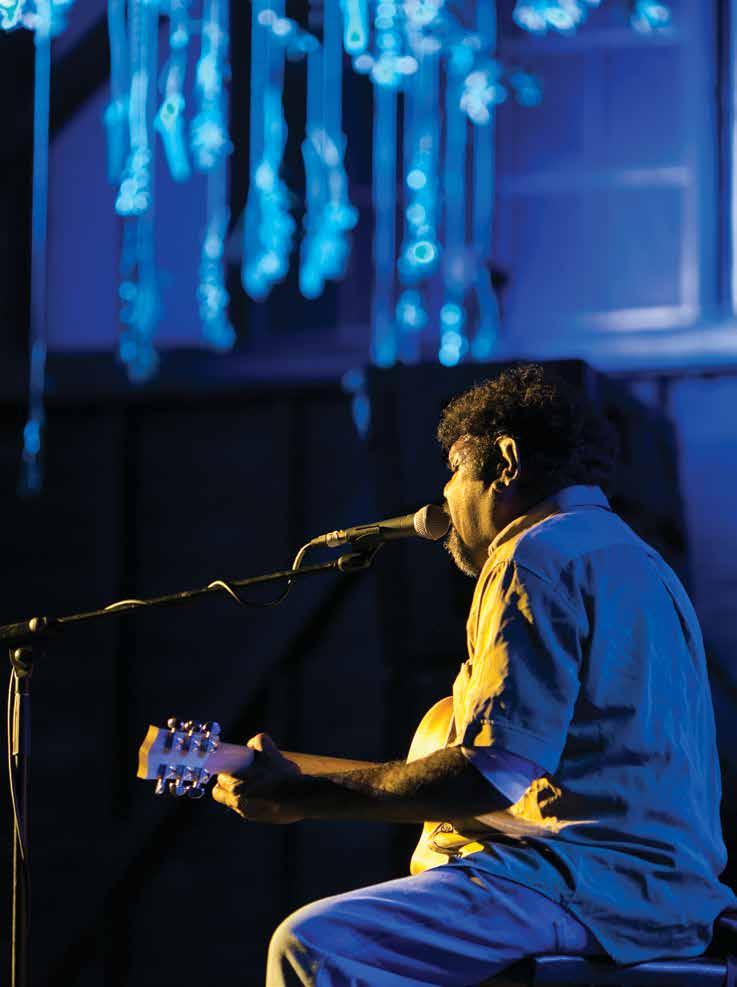

THE TECHNOLOGy OF TRAVEL
16 August 2014–22 February 2015
If you’ve ever wanted to pilot an airship, ride on a hovercraft or load a cargo ship, now is your big chance! Going Places is an interactive science exhibition that explores the technology humans have developed for travel, and the way that travel has shaped the social fabric of our time.
The exhibition explains the physics of transport and tells its personal and humaninterest stories. It covers many different aspects of transport, including the movement of people and goods by land, sea and air. Visitors will observe, understand and use a wide range of travel technology to see how it makes our lives easier and better. Learn how the ingenious designs researched and developed over time have overcome Earth’s awesome size and natural processes
– such as gravity, wind, currents, waves, friction and changing landscapes.
Visitors will appreciate the need for the continuing development of sustainable technologies for travel and living, and will also see pioneering technology to make the farthest reaches of our planet accessible.
Designed for families with children aged five to 12, the exhibition is fun for all ages. Going Places will be a wild ride!
Going Places – produced by Scitech, Perth, Western Australia
01 Going Places exhibition entrance and virtual Earth. Photograph courtesy Scitech
02 Australian submarine HMAS AE2 with crew on deck at Portsmouth, 1914. ANMM Collection
03 Migrants on MV Toscana at Trieste, Italy, 1954. ANMM Collection Gift from Barbara Alysen. Reproduced courtesy International Organisation for Migration
04 Minke Whale Portrait, Bryant Austin (detail)
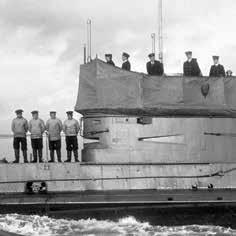


War at sea – The navy in WWI
12 September 2014–3 May 2015
The Royal Australian Navy (RAN) played a significant role in World War I, and served in all theatres of war, from the Pacific and Indian oceans to the Mediterranean and North seas. Its story will be told through the experiences of sailors – the drudgery of patrolling and blockading, the intense actions of battle, and the incredible voyage of submarine AE2 through the Dardanelles Strait – and via first-hand accounts from diaries and journals, objects, and film and interactives.
Coming to Australia –Photographs from the Iro and ICEM
Until 2 November
To mark Refugee Week, a small selection of photographs highlights the work of the International Refugee Organisation (IRO) and Intergovernmental Committee for European Migration (ICEM) in the 1950s. The photographs capture in vivid detail the anticipation and anxiety of European migrants coming to Australia in the turbulent years after World War II.
Beautiful Whale – life size photography by Bryant Austin
Until 1 February 2015
Come eye-to-eye with whales at sea in this remarkable photographic exhibition. American Bryant Austin is the only photographer in the world producing life-size images of whales, including dwarf minke whales from the Great Barrier Reef, sperm whales from the Caribbean and humpbacks from the South Pacific. Austin takes up to three months to become accepted into a group of whales then, using just a snorkel, he floats at the surface waiting for a whale to come less than two metres from his camera lens. At this distance, all of its true colours, subtle tones and fine details can be captured.
Funded by the USA Bicentennial Gift
East Coast Encounter –re-imagining the 1770 encounter
Until 24 August
East Coast Encounter is a multi-arts initiative involving Indigenous and non-Indigenous artists, writers and songwriters to re-imagine the encounter between James Cook, his crew and Aboriginal people in 1770.
This project has received administrative and financial support from Sunshine Coast Council, Museum and Gallery Services
Queensland, The University of the Sunshine Coast, Arts Queensland and the Australia Council.
eastcoastencounter.com.au
Too replica skiff
Until 24 October
This cedar 18-foot skiff was recently built along the lines of its historic namesake from 1951 – Myra Too. Built and sailed by legendary boatbuilder Bill Barnett, Myra Too dominated racing that season, winning the New South Wales, Australian and World Championships. It was one of the highlights of Bill’s long career as a master shipwright in Berrys Bay, Sydney. The museum assisted with research for the replica’s design and construction, and created a huge online following as the project progressed. You can see the skiff and its beautiful timber construction in the museum’s Wharf 7 Maritime Heritage Centre.
ANMM travelling exhibition
Waves & Water –
Australian beach photographs
Manning Regional Gallery
9 August–21 September
Iconic photographs from the Australian National Maritime Museum’s collection capture Australian beach culture from the 1930s to 2000: sunbathers, swimmers, surfers, surf lifesavers and ocean pools, by Max Dupain, Jeff Carter, Ray Leighton, Ian Lever, Roger Scott, Anne Zahalka and Narelle Autio.

Life on a small and isolated island is, of course, inexorably defined by the sea. The history and culture of Norfolk Island, and the psyche of its people, are all deeply connected to the waters surrounding what they fondly call ‘the rock’, writes Lisa Richards, director of the Norfolk Island Museum.
nOr FOlk islan D measures eight by five kilometres and is located 1,200 kilometres northeast of sydney. For such a small and peaceful place, norfolk has a dramatic history. it includes British settlement in 1788; the wrecking in 1790 of hms Sirius (flagship of the First Fleet that brought the initial settlers to the colony of new south wales); the notorious treatment of convicts when it opened as, in the words of new south wales Governor sir t homas Brisbane, the ‘ne plus ultra of convict degradation’; and finally as the settling place for the descendants of the Bounty mutineers. t he norfolk island museum, located in world-heritage-listed k ingston, tells these stories and showcases many nationally significant artefacts.
t he earliest items on display, however, are Polynesian, dating from 1300–1500a D. when Captain James Cook first sighted the island in 1774 he found it empty and was unaware of any previous occupation. we now know that norfolk island was the most westerly point of Polynesian migration and the only place they settled in australia. while questions of why they came and left remain unanswered, archaeological digs in the late 1990s revealed significant clues as to their time on the island. Finds included a marae (cermonial meeting place), oceanic earth ovens, hearth stones, timber housing and midden remains, adzes and bone fish hooks. it is thought that from the original 20 to 50 people, the population grew to a few hundred, with the main settlement behind emily Bay at k ingston. Clues to their origin came from 26 pieces of obsidian sourced to r aoul island in the kermadecs (1,450 kilometres north-east of new Zealand). a side from a number of adzes
found over the years, when they departed the Polynesians also left behind bananas and Rattus exulans, the Polynesian rat, which arrived as stowaways in the oceangoing wakas (canoes).
Captain Cook recorded two items on the island of great potential use to Britain: the flax plant Phormium tenax, which he hoped could be made into sail cloth, and the norfolk island pine Araucaria heterophylla, for possible use as ships’ masts. access to timber and marine supplies from norfolk island, new Zealand and new south wales became a key reason in the British government’s choice of new south wales as the location for a new colony.
t here, a Pacific boatbuilding base could be established that would support the expansion of naval and British east i ndia Company interests in east a sia and overcome recent losses of resources from Baltic ports and from north a merica following the war of i ndependence. Before the First Fleet left england, plans were therefore made to settle uninhabited and resource-rich norfolk island. t he fleet arrived in Botany Bay on 26 January 1788, and within a week encountered the French explorer the Comte de l a Pérouse on L’Astrolabe and learnt that his expedition had just come from norfolk island but that rough conditions prevented landing. t his meeting must have prompted new south wales Governor a rthur Phillip to hasten settlement of the island, which occurred just six weeks later, on 6 march 1788.
norfolk island pines proved to be unsuitable for masts – but the empire’s loss is the island’s gain, as otherwise there would surely
be none left standing. t he first commandant of the settlement, l ieutenant Philip Gidley k ing, tried hard to fulfil his orders to process the flax plant. when all attempts proved fruitless, he resorted to an extreme measure. i n the museum collection, two prestigious ceremonial patu (stone hand clubs) tell the story of k ing having two maori men ‘acquired’ – in reality kidnapped – in 1793 and brought to the island to instruct in the processing method. Unfortunately for k ing, those men – tuki, the son of a priest, and huru, the son of a chief – quickly let him know that they knew little of flax processing, as it was women’s work. During the maoris’ ninemonth stay, however, their relationship with k ing became a positive one based on genuine mutual respect. t hey were the first maori to live in a european community, staying in Government house with k ing, his wife and young children. k ing recorded maori vocabulary and customs in his journal. tuki drew one of the earliest maps by a maori, of his homeland at the tip of the north island. First drawn in the sand, it was then transferred to paper (and is now in the U k national a rchives). t he map is a testament to the quality of communication that occurred between the men as it uniquely records social, mythical and political features in the landscape. when k ing personally accompanied them home on Britannia he was presented with gifts of thanksgiving for their safe return, including the patu. k ing was never to learn that the norfolk flax species’ resistance to processing was due to its low fibre content.
i n 1798 the first locally constructed ship, a 16-tonne sloop made of norfolk pine and named Norfolk, was confiscated on arrival in sydney after its maiden voyage. shipbuilding was expressly forbidden in the norfolk settlement. t he ship was then used by George Bass and matthew Flinders to discover Bass strait and circumnavigate tasmania. i n 1800 at Broken Bay, Norfolk was seized by 15 convicts who sailed it north, but their poor seamanship saw it wrecked on rocks near stockton (newcastle), some 50 kilometres north of sydney. t he norfolk island museum proudly displays a 50:1 model of Norfolk, made by Col Gibson of newcastle.
Undoubtedly the most serious event to occur during the early life of both the Port Jackson and norfolk island settlements was the wrecking of hms Sirius on the reef at sydney (now slaughter) Bay. By early 1790 the Port Jackson colony was existing on half rations and on the verge of starvation. Sirius was sent on a desperate mission
to Canton, China, to buy supplies. On the first leg of the journey it was accompanied by Supply to transport 116 convict men, 67 convict women, 27 children and 65 marines to norfolk – thereby offloading their ‘feeding burden’ from Port Jackson to norfolk island. t he circumstances of Sirius ’ wrecking were officially recorded by those on board, including Captain John hunter and l ieutenant william Bradley, and in the personal journal of l ieutenant r alph Clarke. Philip Gidley k ing recorded his impressions as a land-based witness in his journal, and the event was also captured in paintings by Bradley and the Sirius midshipman George r aper. a ll show that while unloading supplies, both Sirius and Supply began to drift too close to the reef. a s they began a manoeuvre to tack out to sea, a fickle wind change forced hunter to turn Sirius on an inward tack in the hope of sailing back along the length of the reef, escaping out to sea between nepean island and Point hunter. a fter turning, the ship was again too close to the reef so hunter tried but failed to change tack and the wind blew Sirius backwards onto the reef.
‘You never saw such dismay as the news of the wreck occasioned amongst us all’
we know not only the sequence of events that led to Sirius ’ wrecking and the immediate frantic activity to save lives and precious stores, but also the serious practical ramifications and psychological effect its loss created. t hough no lives were lost, Governor Phillip recorded, ‘you never saw such dismay as the news of the wreck occasioned amongst us all; for, to use a sea term, we looked upon her as our sheet anchor’. without Sirius the only means of contact with the outside world for both settlements was the small 170-tonne Supply. Food rations were immediately further cut in Port Jackson. t he burgeoning population on norfolk island suffered ration cuts and martial law, and for the two long years before Sirius finally disappeared below the water line, also had to endure the daily sight of the ship stuck fast on the reef as a reminder of their loss and isolation.
One venue of the norfolk island museum is entirely dedicated to the Sirius story and the display of its artefacts – the largest collection of First Fleet cultural heritage material in australia. i n 2015 this venue will be the focus of a major week-long
celebration of arguably australia’s most important shipwreck, culminating on 19 march with the 225th anniversary of its wrecking. a special focus for the week will be the story of the 1980s maritime archeological expeditions to recover its artefacts through the Sirius Project, which occurred in the lead-up to australia’s Bicentenary celebrations. Four expeditions between 1983 and 1988 raised approximately 3,000 artefacts, including a 1.7-tonne anchor, carronades, ballast, cannon balls, scientific equipment and fine pieces from the officers’ cabin. Our guest presenters will be team leader Graham henderson and myra stanbury, registrar and curator of the expeditions. Graeme and myra are the co-authors of The Sirius: Past and Present, a comprehensive book on the ship’s history and archaeology. Graeme was the Foundation Director of the western australian maritime museum and myra is a curator with the western australian museum’s Department of maritime a rchaeology. we are delighted that Graeme and myra will be back together on ‘the rock’ for these special presentations. For First Fleet descendants and maritime enthusiasts alike, this will be an important week.
t he norfolk island museum’s involvement with the western australian museum has related both to Sirius and to one of the most infamous maritime events, which eventually became part of norfolk island’s story: the 1789 mutiny on board hmav Bounty. Fletcher Christian and his fellow mutineers cast l ieutenant william Bligh and his sympathisers adrift in a longboat and then, with their tahitian female partners, settled on isolated Pitcairn island. i n 1986 an raa F hercules aircraft transported one of the Bounty ’s cannons, plus an anchor and two carronades from Sirius, from norfolk island across the continent to Perth for treatment at the Conservation Department at the western australian museum. t hat cannon is now displayed in our museum with other major Bounty artefacts, including a large copper urn that was used to brew grog and beside which drunken mutineer John adams said he received a vision of st m ichael the a rchangel, resulting in his conversion. he then made it his mission to teach the island’s children to read using the Bounty ’s Bible and Book of Common Prayer. Other artefacts include rudder pieces and nails and the ring owned by mutineer edward young that, as the only one available, was used to marry each of the tahitian women to their mutineer partners and then through subsequent generations for the next 30 years.
01 Page 46: Evocative memorials in Norfolk Island’s cemetery. All images courtesy Norfolk Island Museum unless otherwise stated
02 The Melancholy Loss of HMS Sirius off Norfolk Island March 19th 1790, George Raper. National Library of Australia
03 Anniversary Day on the island, 1932.
04 The HMS Sirius Museum.
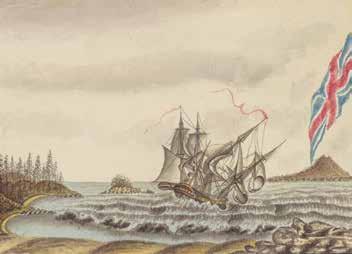





Our local phonebook today reveals many descendants of the mutineer names: Christian, Quintal, adams and mcCoy, and later arrivals on Pitcairn of Buffet, evans and nobbs. every year on 8 June the families celebrate a nniversary Day (Bounty Day), marking the arrival on the Morayshire in 1856 of their ancestors from Pitcairn island, which they had outgrown. t hey brought their unique culture and language developed from the mix of their english and tahitian forebears, which grew to become its own distinct language called norf’k. Despite assimilation policies and previous misguided attempts to have it banned from being spoken at school, it has survived and is now part of the curriculum at the local school.
01 World-Heritage-listed Kingston, Norfolk Island. David Kirkland Norfolk Island Tourism
02 The Bounty ring, which as the only one on the island was used in marriage ceremonies for three decades.
03 Polynesian artefacts, c 1300–1500.
while our local maritime stories since 1856 are not as famous as those of the Sirius or the Bounty, they are of high local importance, having been integral to the fortunes and running of the island. t he Pitcairners’ consummate boathandling skills and knowledge of whaling from prior work on a merican whalers were immediately put to use, with the establishment of a local whaling industry bringing much-needed cash into the island economy. t he whalers used open new Bedford-style whaleboats, and several graves in the cemetery bear witness to the dangers
of this endeavour. i f a harpooned whale towed the boat over the horizon as night fell, fires would be lit around the cliffs to help with the men’s hazardous return. t he industry continued with a few breaks until the 1940s and then briefly again with a modern station in the late 1950s, before failing in the early 1960s due to the dramatic decrease in passing whales from illegal russian whaling around a ntarctica. Before world war ii, when an airstrip was built, all access to the island was by sea. l ack of reliable shipping to take fresh produce to mainland markets saw ‘whole of community’ ventures firstly to purchase and then, in 1923, to make their own boat, the mv Resolution while these both sadly failed, they have become symbolic of the ingenuity and resilience of the islanders’ spirit, and their determination to control their own fortunes. today the island depends on the boatmanship of the men who unload the ships that bring most of the island’s freight, ensuring that food is on the shelves at our local supermarket.
with no deep-water port, ships anchor about one kilometre offshore and cargo is transferred to open 10-metre-long lighters using pallets or nets, as standard containers cannot fit into the small lighters. motorised launches tow the lighters in, then let them

go, to be steered alongside the pier using a sweep (long oar). l arge items such as buses or trucks arrive on two lighters strapped together. l ighters are shaped like the whaling boats, but are deeper and wider for greater stability and capacity. t he increase in size means they are sturdy but cumbersome to manouevre, requiring considerable skill to handle them. it can be hazardous work, as one- to two-metre swells can occur and there is an outcrop of rocks at the end of the k ingston Pier. On a good day, however, the men can unload 600 tonnes. ‘werken a’ shep’ (working the ship) occurs in much the same way as it has since the arrival of the men’s forefathers in 1856, and indeed since ships began calling at the island from 1788. a s has always been the case, the elders teach the skills to the younger men.
norfolk’s stories also include those from the second penal settlement between 1825 and 1855 when the island became, as new south wales Governor sir r alph Darling put it, ‘a place of extremist punishment, short of Death’. t he formidable ocean moat between the convicts’ prison and mainland freedom became the setting for numerous mutiny and escape attempts. Unsurprisingly, many of these finished at the gallows, with the headstones at the norfolk island Cemetery still vividly describing the convicts’ fate.
Our island life will always be tied to the ocean. t hat so many major maritime stories have also crossed our path, leaving behind artefacts of national significance for australia, makes us a desirable destination for those whose interests include the sea. at the norfolk island museum we appreciate our good fortune and privilege in caring for and presenting those artefacts. we sincerely welcome your visit.
The Norfolk Island Museum operates four museum venues, a historical play and a cemetery tour. Details on the collections, tours and tickets are at www.museums.gov.nf
The 225th anniversary of the wrecking of HMS Sirius will occur on 19 March 2015. Details on planned events can be found at www.norfolkislandtravelcentre.com/events/ anniversary-of-the-wrecking-of-the-hms-sirius
Norfolk Island was the most westerly point of Polynesian migration and the only place they settled in Australia
The museum’s HMB Endeavour replica will soon put to sea in a series of voyages planned around various events or themes, or tied to local festivals and celebrations. All are designed to evoke the experience of 18th-century sailing. Endeavour ’s master John Dikkenberg previews some of the expected highlights.
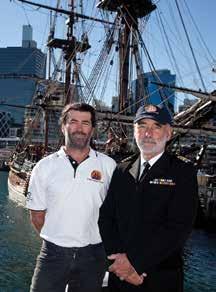
The ship is a tangible link to 18th-century maritime exploration and charting
ENDEAVOUR has twO rOles: museum display and seagoing ship. i n the second, she has covered thousands of kilometres, and will soon put to sea again for another round of voyages. i n the same way that the ship is a tangible link to 18th-century maritime exploration and charting, some of the voyages will try to recapture the essence of that period. Other voyages will enable passengers to view our broader maritime history – such as the transport and incarceration of convicts – from a ship of that age, while some will allow Endeavour to participate in local festivals and celebrations. t his last aspect of voyaging should not be underestimated, for most people associate closely with Endeavour and all enjoy the theatre of historic tall ships that she brings to their port.
each seagoing period comprises a number of voyages. t his allows passengers more choice of itinerary and length of voyage, while also making it easier for the museum to gather the crew from around australia. square-rig crews are a rare commodity and in Endeavour we seek crew members who have plenty of experience and the right attitude to operate the ship in a way that enhances the sailing adventure for our guests. it is the crew, far more than the ship, that generates our sailing environment. so with those factors in mind, the ship’s program over the next 12 months or so is quite diverse and all the voyages are
structured to appeal to those wishing to join the ship as voyage crew (active participants) or supernumeraries (who can participate as much or as little as they wish, or simply relax and fill the days as they choose).
i n early september, Endeavour will sail for three five-day periods. t he first of these is designed for people who do not necessarily want to sail at sea overnight. t he ship will sail each morning and anchor each afternoon, either in Pittwater or sydney harbour. During the evenings, the crew will brief the passengers on the next day’s sailing and teach them progressively more about the rig and sails.
During the following two periods, we aim to give passengers a sense of the sciences practised in Cook’s ship. For the first of these, the ship will embark two botanists sailing from sydney to Pittwater. Our young gentlemen of science will give a number of lectures and take people ashore to collect botanical specimens. Back on board, they will teach those interested how to draw botanical specimens, and passengers will leave the ship with a sample of their artistic skill to recall the voyage. a major feature of this voyage will be the collection of native seeds for the seed bank at sydney’s royal Botanic Gardens.
a fter a day at anchor, Endeavour will sail for newcastle and an exchange of gun salutes with Fort scratchley. Coming home from that harbour city, we will concentrate on
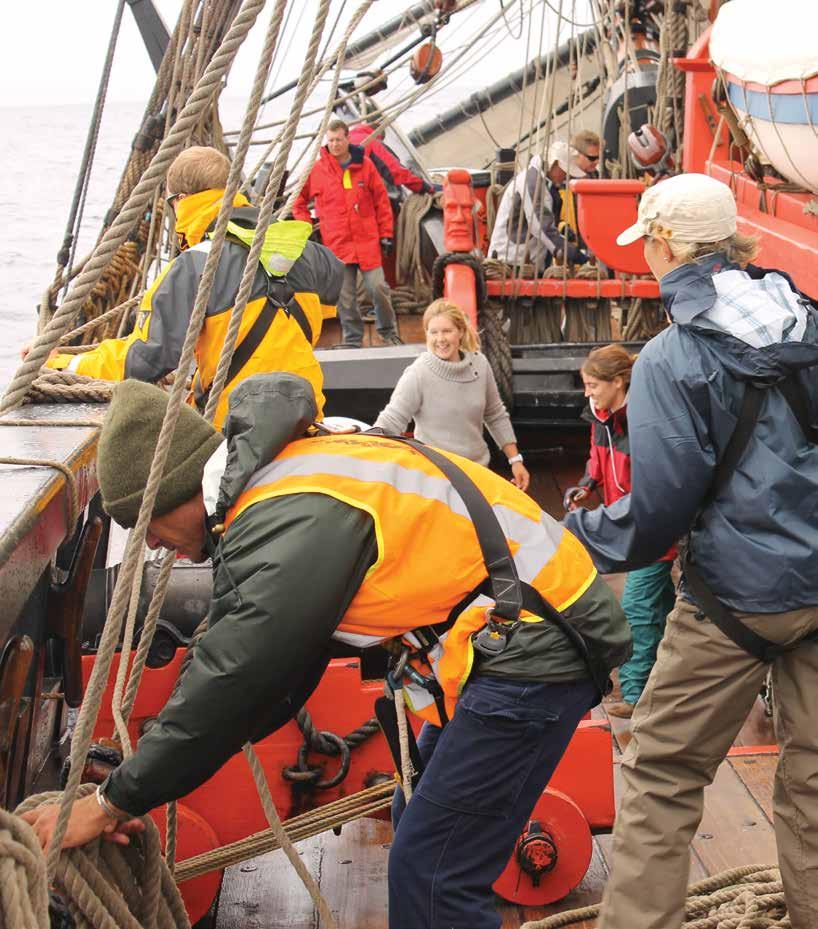 01 Endeavour’s master John Dikkenberg (right) with first mate Anthony Longhurst. All images ANMM photographers
01 Endeavour’s master John Dikkenberg (right) with first mate Anthony Longhurst. All images ANMM photographers

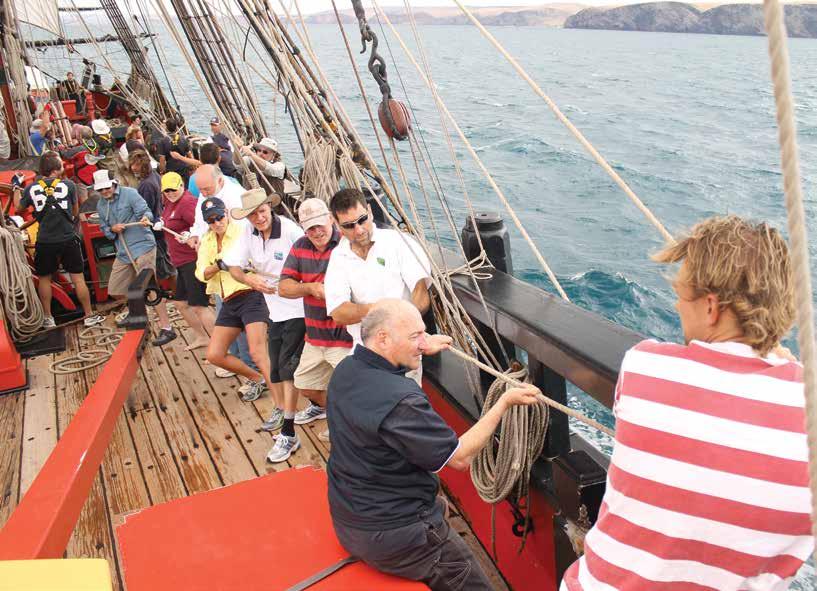
using the sextant to establish latitude. t he voyage will include an evening in Pittwater that features a lecture on the galaxy and a turn at star-gazing under the tutelage of astronomer Dr Fred watson. Back in sydney harbour, we will launch the pinnace and row the seeds collected for the seed bank ashore in Farm Cove.
i n late October, the ship will head to eden for its whale Festival. t he voyage south is programmed to take 10 days, allowing plenty of time to truly sail and practise the new skills acquired. On our last 10-day voyage we sailed about 900 nautical miles (1,700 kilometres), taking advantage of every variation in the weather to sail Endeavour in the way she enjoys. a stop in pristine Jervis Bay is also possible. t he voyage home to sydney will be a relatively quick five days, retracing the track Cook followed.
A major feature of one voyage will be the collection of native seeds for the seed bank at Sydney’s Royal Botanic Gardens
i n the new year, the ship will sail south on a voyage of modern-day exploration aimed at those who love great scenery and revel in maritime and convict history. a fter departing sydney, Endeavour will sail into Bass strait, pass to the west of Flinders island and anchor off maria island and Port a rthur in tasmania. t here is something almost surreal and spiritual about an 18th-century wooden sailing ship anchored in locations of such human deprivation and cruelty. i n both places, voyage crew and supernumeraries will have an opportunity to go ashore and visit the convict ruins. Following a very early morning departure, Endeavour – hopefully in company with a number of other tall ships – will cross storm Bay and enter hobart as part of the Parade of sail and the australian wooden Boat Festival. For those who have not been to the show, i can only say it is probably the largest wooden boat festival in the world, with several hundred craft alongside the marina and more than 200,000 visitors passing through the gates.
Following the boat show, the ship will sail down the d’entrecasteaux Channel and visit recherche Bay and Port Davey. i f you read a rthur r ansom’s Swallows and Amazons as a youngster, you’ll find your childhood rushing back.
Depending on weather, Endeavour will then voyage up the west coast of tasmania, where voyage crew and supernumeraries may transfer to smaller boats off macquarie harbour, pass through hell’s Gate and visit sarah island. On the run back to hobart, we will pass outside Great Bruny island and anchor in adventure Bay. t his bay has previously hosted Cook himself in Resolution, william Bligh in Bounty and Providence, tobias Furneaux in Adventure, nicolas Baudin in Géographe and Bruni d’entrecasteaux in Recherche. abel tasman in 1642 and matthew Flinders in 1798 also attempted to anchor there. t heir spirits will no doubt recognise the ship as Endeavour ’s stream anchor beds itself in where their own ships rode out the weather and watered.
Following a last visit to hobart, the ship will retrace her voyage down from sydney. a fter passing through the Furneaux Group of islands and crossing Bass strait, we will aim to make landfall on Point h icks and follow Cook’s run up the coast of new south wales.
Further voyages are still being negotiated and finalised, but a voyage into the near Pacific is on the cards and perhaps also a voyage to adelaide for its maritime Festival in October/ november 2015. Both will be planned around significant aspects of maritime history in australia and the south-west Pacific. we will also need to find time to bed the old girl down for her biennial survey docking. a check of the underwater areas and a coat of antifouling paint will ensure she continues to meet her commitments to the museum and the people of australia.
A brochure detailing the proposed voyages is included with this issue of Signals. Information can also be found on the museum’s website. You can also follow Endeavour on Facebook.
John Dikkenberg has been at sea or in the maritime industry for most of his working life. He joined the Royal Australian Navy in 1966 and, after graduating, served at sea in destroyers and the troop transport HMAS Sydney before joining the submarine service in 1972. He subsequently served in all the Australian submarines and the British submarine HMS Orpheus, and was the Commander of the Australian Submarine Squadron from 1989 to 1993. He joined the Sydney Heritage Fleet in 2006 and frequently sailed as captain of the barque James Craig. He became captain of Endeavour in May 2013.

One of the more important aspects of any voyage in Endeavour is the weather. If the winds are fair, the ship will enjoy smooth seas and an unencumbered passage in good time. If the winds are foul, the passage might be very uncomfortable and could take much longer than anticipated to complete. So how do we allow for this?
All our voyages are planned to achieve modest daily distances. The voyages to and from Hobart, for instance, are planned to take about 10 days. Even allowing for two periods at anchor, the ship will rarely have to sail more than about 80 nautical miles (150 kilometres) a day – an average speed of about three and a half knots, or 6.5 kilometres, per hour). Where we make no headway at all, we keep a very careful eye on the speed required to make our arrival time. If the speed required becomes a challenge, and the wind is not fair, we will reluctantly motor. On several voyages to Hobart as the former master of James Craig, I had to motor for short periods but generally enjoyed brilliant sailing for almost the entire voyage.
01 Good weather and a pretty anchorage offer the chance for a dip.
02 When sailing a tall ship, voyage crew literally learn the ropes.
03 John Dikkenberg at the helm.
In extreme weather, we will run before it or seek shelter. Sailing down the eastern coast of Australia there are many safe anchorages. Should we encounter severe weather that precludes us sailing up the west coast of Tasmania in February, we have equally enticing sheltered-water destinations such as Coal Mines in Norfolk Bay. It was here that Port Arthur’s worst inmates were sent.


01 Climbing to a local landmark, Castle Rock, in late April to view the last sunset for the season. Photograph Megan Absolon
02 Bridging a crack in the sea-ice on the McMurdo Ice Shelf for the Hagglund vehicle to cross. Minimum safe ice thickness for driving is 80 centimetres. Photograph Martin Meldrum
Ice caves, auroras, inquisitive wildlife and evocative memorials are just some of the sights awaiting those fortunate enough to spend time in Antarctica. Former ANMM employee Sue Bassett , based in Antarctica through the winter, recounts a few of the experiences and excursions to be had in this vast frozen land.
antarC tiC a is a massive and barren continent about twice the size of australia and almost entirely covered by ice. while it is a land of mountains, volcanoes, hills and glaciers, it is also often featureless, and certainly devoid of most of the landforms we’re used to seeing, thereby providing little context for judging distance or height. mountains that seem close are unreachable, and most of the landscape’s intricacies remain unrevealed secrets. But for those of us living here for a period, a ntarctica offers many fascinating things to do, discover and explore. while we at scott Base don’t get out much during the long dark months of winter, during the intermediate times of perpetual twilight and the 24-hour daylight of summer there are some great walks in the vicinity of the base, activities to participate in, and some further-afield excursions to enjoy.
Mountains that seem close are unreachable, and most of the landscape’s intricacies remain unrevealed secrets
skiing is popular and, in addition to cross-country and skate-skiing, scott Base has a ski-field complete with rope tow, and a good supply of downhill skis and snowboards. it operates in summer and is a great way to spend a day off. Conditions permitting, kite-skiing over the sea-ice is another option for the experienced, or it can be fun to simply walk among the pressure ridges following a flagged route. For the more adventurous,
there are organised crevassing trips – exhilarating indeed, but not for the fainthearted. t hey involve being lowered into a narrow, dark, seemingly bottomless crevasse with harness, ropes and crampons all securely attached – an experience best enjoyed with a strong grasp on both camera and trust, and leaving the ‘But what if …?’ thoughts well behind.
a number of hills offer good climbing and views over the frozen landscape, occasionally over open water, and there are a couple of heritage sites with built monuments to visit. no climb beats that of Observation h ill, a sharp, rubbly 230-metre peak named in 1901 by Captain robert Falcon scott. he described it then as ‘an excellent look-out station for observing the going and coming sledgeparties’. a decade later, during his next expedition in 1912, members of scott’s team


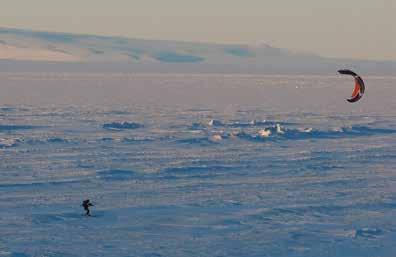




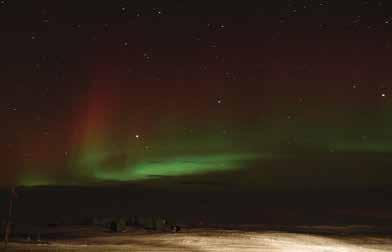
01 Preparing to descend into a crevasse. All photographs by Sue Bassett unless otherwise stated.
02 Looking up from inside the crevasse. Photograph Stefanie White
03 Inside an ice cave. Photograph Stefanie White
04 Taking a better look at the fuselage of the wrecked US Navy C-121 Lockheed Super Constellation aircraft, Pegasus
05 Kite-skiing across the sea ice.
06 Vince’s cross at Hut Point.
07 Colourful nacreous clouds, or polar stratospheric clouds, can be seen at the end of winter as the sun is re-emerging.
08 The unearthly beauty of aurora australis
09 Memorial cross to Captain Robert Falcon Scott and his polar party, who perished in 1912. The cross stands on Observation Hill, overlooking the Ross Ice Shelf, and faces towards the South Pole.


made the climb as they eagerly awaited the return of their leader and his polar party, who unfortunately never re-appeared, all perishing on their return journey from the south Pole. atop the hill his men erected a cross of australian jarrah in memory of scott and his team, inscribed with their names and an epitaph from tennyson’s Ulysses: ‘ to strive, to seek, to find, and not to yield’.
a nd then there’s vince’s cross near scott’s Discovery hut at hut Point. able seaman George t vince, rn, was a member of scott’s Discovery expedition (1901–04) and part of a team returning in a wild snowstorm from a harrowing sledging trip, when, from among his mates, he lost his footing on an icy slope and skidded past them over an ice cliff into the sea, never to be seen again.
a nother evocative site, but one that is thankfully less tragic, is the remains of a Us navy C-121 l ockheed super Constellation aircraft, Pegasus, which crashlanded on the ice runway in bad weather in 1970. no lives were lost, and the aircraft was dragged off the runway, where it now lies half buried in snow and makes for an interesting half-day excursion.
t he highlight for us, though, comes in the returning light at the end of the long winter, when the a ntarctic heritage trust conservation team travels by hagglund vehicle over the sea ice to scott’s Terra Nova hut at Cape evans to carry out a post-winter inspection and document how the hut has
fared through the storms and winds. t his involves a scott Base support team testing the ice thickness and flagging a safe route ahead of our visit, bridging cracks in the ice as required.
l ast year we were fortunate to encounter a couple of large icebergs, complete with an ice cave, trapped in the sea ice along the way. Following appropriate safety checks, we were able to crawl inside to be awed by the crystal formations and their artful manipulation of light.
We must keep a 10-metre distance from all wildlife, but they are often just as inquisitive as us and don’t bother with such strictures, so we can have some quite close encounters
it is not uncommon on our excursions to encounter wildlife, especially before the winter sets in. weddell seals and adelie penguins are fairly common around ross island and will appear and disappear through cracks in the sea ice. emperor penguins and killer whales can also be seen,
but are less common. t he emperors huddle in groups and are exuberantly vocal, often breaking unexpectedly into single file to walk long distances over the ice to nowhere in particular, only to huddle again and holler some more. t he scavenging skua gulls are also about, always on the lookout for a vulnerable adelie penguin chick. Our environmental rules oblige us to keep a 10-metre distance from all wildlife, but they are often just as inquisitive as us and don’t bother with such strictures, so we can have some quite close encounters.
Other things we can marvel at, being close to the bottom of the world, are the solar and lunar patterns of rotation around the horizon. at times dipping like a huge 360-degree roller-coaster rather than rising and setting, the sun and moon put on displays more spectacular and intense than i’ve ever encountered, often with simultaneous sunset and sunrise displays. Other colour-filled attention-grabbers are the polar stratospheric clouds, or nacreous clouds … but nothing quite beats aurora australis, created by the passing plasmafilled solar winds, which, for me, epitomises the wonderland that is a ntarctica and reinforces just how lucky we are to be here.
To learn more about the Antarctic Heritage Trust’s work and follow the on-ice activities of the team during the winter of 2014 through weekly Antarctic blogs, go to nzaht.org or visit the Trust’s Facebook page facebook.com/antarctic.heritage.trust



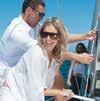


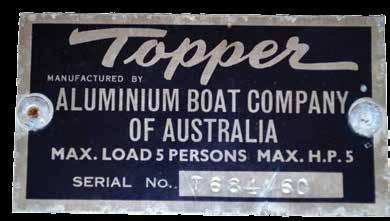
01
02 A 1961
The latest listings on the Australian Register of Historic Vessels highlight how preserving these historic craft helps to maintain the methods used to build them, writes its curator David Payne. Just as important, it also records social practices that are a major element in the story of these boats.
when 13-year-Ol D an Drew hal Dane made the 3-metre-long plywood dinghy for his father and uncles’ fishing vessel mv Tacoma in 1963, it became part of his passage into the family business, and reflected the practical hands-on approach that had brought the family success. Brothers william, a lan and hugh haldane had built the big Tacoma themselves in Port Fairy, victoria, then in the early 1950s loaded their three families – pets included – aboard the vessel and moved across to Port l incoln in south australia. t here they eventually established a viable method of catching tuna, and in so doing established a multi-million dollar industry and put a town on the map.
t he haldanes were brought up to be selfsufficient, so when a dinghy was needed, teenager a ndrew built it, using a merican
plans published in a book and modified to produce a night-time, live-bait fishing craft, replacing an earlier and heavier tender that had not met expectations. t he ply dinghy was built to fit on board Tacoma with the other support craft, a flattie and a dinghy. it was used for a number of years, but as Tacoma ’s roles evolved, the dinghy became redundant and went into storage on shore. Tacoma was retired in 2003, and in the last decade has taken on a new life under the Tacoma Preservation society, supported by the haldane family. a long with Tacoma ’s two other support boats, the dinghy was restored and has earned its own place as a historic vessel. it is recognised on the arhv as a dinghy but one with a specific role on the Tacoma, along with the story of how it reflects the haldane family’s practical ethos, handed down and maintained over the generations.
Preserving and then learning from the past were the reasons for nominating Garbo, one of two or three surviving shark Bay pearling luggers. i n contrast to the north west luggers such as Ancel, which took divers into deep water off Broome, the shark Bay industry was based on dredging shell from shallow water, and the sturdy, cartwheel-construction stern was built specifically to suit the handling of the dredging operation over the stern. Garbo has since come ashore, and over time has collapsed outward from the centreline. it sits in storage at the western australian maritime museum in a sculptural state, well supported on a cradle but splayed out wide like a surrealist image. t he key point is that all the structure including the half-round stern is there to see, so despite its curious presentation the scantling configuration is complete and it serves
This online, national heritage project devised and coordinated by the Australian National Maritime Museum reaches across Australia to collate data about the nation’s existing historic vessels, their designers and builders, and their stories.
as a valuable reference point to learn about the type and its working methods.
aboriginal culture is built on the practice of passing knowledge from one generation to the next, and two more watercraft from the australian museum preserve this knowledge with two different methods of construction. t he sheet-bark yuki-style canoe has little known background, but as one of the few surviving examples of the type, it serves as a reference for the current communities building craft on the murray and Darling river systems. t he a rnhem l and dugout canoe is a relatively short example of the type and was built as a gift for a paediatrician named Dr k night in the mid-1950s.
Advertisements claimed that the only maintenance a tinnie required was to ‘simply hose down after use’
Possibly made to this size so he could bring it back to sydney easily, it still captures the essential characteristics and methods of building a dugout canoe. By this period the traditional watercraft of the north were almost completely abandoned by their communities and contemporary dinghies had replaced them. e xamples like this served at the time to help keep the culture alive and continuing.
One of the craft that took over from the dugout was the ubiquitous aluminium ‘tinnie’, a vessel that is very much a part

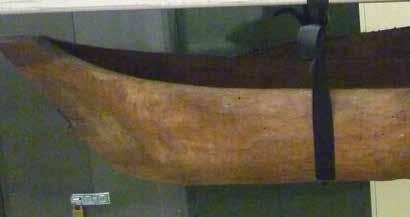

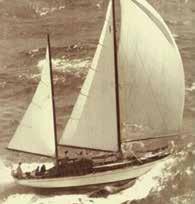

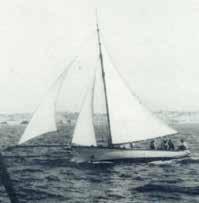
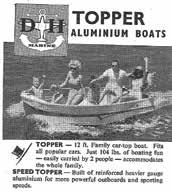
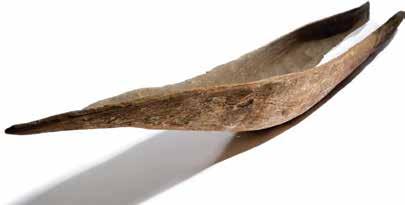
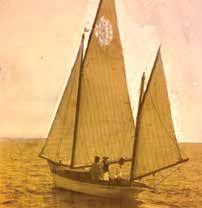

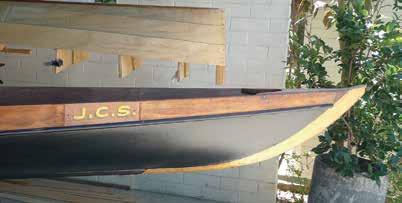




of contemporary australian boating culture. how many people would realise that the tinnie was an australian creation? it can be traced back to builder terry Quantrill of sans souci, new south wales, another of those resourceful, self-taught, do-it-yourself types who crop up in australian history. Quantrill began his career in the boating market by building small, thin-gauge steelplate motor launches. recognising the need for focused marketing, he promoted them through advertisements. t he December 1946 issue of Seacraft features an advertisement for a 6.3-metre (21-foot) raised-deck launch, citing its advantages and showing a handsome vessel under the trade name Quintrex. t he actual company was Quantrill and a rnold, and its base was Quantrill’s home address on t he Promenade, sans souci, on the shores of kogarah Bay. realising the shortcomings of steel in small craft, Quantrill then pioneered small-craft construction in aluminium, overcoming some of the early technical problems associated with the material and its welding, and creating the tinnie in the process.
By the early 1950s he had developed a sustainable market, which eventually saw competitors join and flourish. From the mid-1950s the tinnie became an immensely popular craft throughout australia, elevating itself into a versatile range of boating applications, and ranging in fit-out from the basic to the highly specialised and purpose-built.
t he arhv now lists a tinnie to help represent this cultural landmark. it’s a De havilland model from 1960, still bearing the buyer’s name penned on the underside of the foredeck, along with the paint finish and Topper trademark it had when it left the shop floor. t hat shows its longevity – two generations of one family have looked after it, and true to the advertisement, the only maintenance it required was to ‘simply hose down after use’.
now the family has given it to the museum, and our Fleet staff are preserving and using the craft in accordance with traditional practice – leaving the thing out in the open, shackled to the nearest fixed object.
The ubiquitous aluminium ‘tinnie’ is a vessel that’s very much a part of contemporary Australian boating culture
All images courtesy of the vessels’ owners except for 01 and 02 (David Payne/ANMM).
To mark 15 years of the Welcome Wall project, Veronica Kooyman turns to the archives to trace the story of the earliest documented European settlers. The tale of the Batavia is one of mutiny, massacre and punishment that has fascinated academics and the public alike. Two of the collaborators escaped capital punishment for their acts but were left marooned in 1629 on the coast of Western Australia. Their fate has been the subject of speculation ever since.

wOU ter lOOs an D Jan PelGrOm De By were marooned on the coast of western australia in 1629 as punishment for their involvement in the mutiny on the Dutch east i ndia Company (vOC) trading vessel Batavia and the subsequent massacre of many of its passengers and crew. t his June marked 385 years since Batavia was wrecked on the houtman abrolhos islands off western australia. since then its story has become a shared legend for t he netherlands and australia.
i n October 1628 Batavia set sail from texel, the largest of the Frisian islands in north holland, on its maiden voyage to the trading port of Batavia (modern-day Jakarta, i ndonesia) in the Dutch colonies. t he ship, one in a convoy of seven, was carrying silver coins, two antiquities belonging to the painter rubens, sandstone blocks for the portico of a gatehouse in Batavia and other goods to trade for a valuable cargo of spices. Officially it carried 341 people, although some last-minute desertions were noted. about two-thirds of those on board were officers and men sailing the vessel; a further 100 were soldiers. a small group of civilian passengers travelling or returning to the i ndies included women and children.
Batavia was under the command of senior merchant Francisco Pelsaert and skippered by a riaen Jacobsz. t heir already hostile relationship deteriorated further as the voyage progressed. m isfortune struck the convoy early, with terrible storms
in the north sea separating some of the ships. Batavia and two other ships rounded the Cape of Good hope together but Jacobsz soon veered the ship off course, taking advantage of an illness affecting Pelsaert. he and fellow crew member Jeronimus Cornelisz, an apothecary and merchant with the vOC, had begun a mutinous conspiracy against Pelsaert. But before they could fully enact their plan the ship hit a reef off the houtman abrolhos group of islands, about 35 kilometres off the western coast of new holland (as australia was then known) and was wrecked.
The 268 survivors were left under the rule of Cornelisz, and what ensued is a horror story
surviving crew and passengers were taken to the various islands, but they had few supplies and no source of fresh water. Pelsaert, Jacobsz and a number of crew set out in search of drinking water. Unsuccessful, they left in the ship’s longboat to sail to Batavia for help. t he 268 survivors on the islands were left under the rule of Cornelisz, and what ensued is a horror story. t he band of mutineers massacred 125 men, women and children who were perceived as a threat to Cornelisz’s rule or a burden on supplies. a ny women who took
In one of history’s great migrations, more than six million people have crossed the seas to settle in Australia. The museum’s tribute to all of them, The Welcome Wall, encourages people to recall and record their stories of coming to live in Australia
their fancy were forced into sexual slavery. Other survivors hastily joined the mutinous group, probably to save their own lives. Cornelisz and his conspirators indulged the very worst of their depravity, expecting no repercussions.
a small group of 20 soldiers, led by wiebbe hayes, was sent by Cornelisz to a nearby island and left stranded to die of thirst and starvation. By chance, theirs was the only island in the archipelago with a supply of fresh water; with that, and wildlife caught for food, they managed to subsist. some of the survivors fleeing from the violent mutineers reached the soldiers and told them of the massacres. a nticipating a confrontation, hayes made weapons out of debris from the Batavia, built a stone fort and posted a watch. t his small group managed to survive a series of attacks from the mutineers and eventually captured Cornelisz. t he mutineers regrouped under the command of wouter l oos, this time armed with muskets, and attacked again. By sheer chance Pelsaert then arrived in the rescue ship Saardam and the revolt was quickly quelled.
while most of the mutineers were swiftly tried and executed, either on the islands or in Batavia, two were granted mercy by Pelsaert. i n his later published account of the disastrous voyage, Pelsaert records a trial held on an island in which l oos, a 24-year-old soldier, admitted taking part in the murder of a preacher’s family, apart from the preacher himself and one
Pelsaert intended for the men to be retrieved at a later date to ‘know for certain, what happens in the Land’


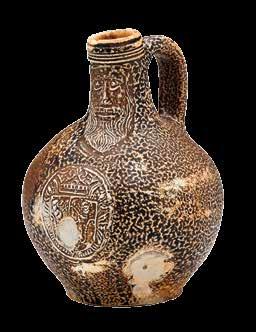
of his daughters who was kept as a slave. t he kindness he reputedly showed two other surviving women stayed Pelsaert’s hand from execution. Jan Pelgrom de By was an 18-year-old cabin boy conscripted into the mutineers’ group after the shipwreck. apparently he took up his role with some enthusiasm, murdering one boy, helping to kill another two, and insisting on decapitating another victim. according to witnesses, de By cried when another mutineer was allowed the ‘honour’ instead. t hough sentenced to hang, he pleaded for mercy, and due to his youth it was granted.
On 16 november 1629 Pelsaert marooned the two on the mainland of what is now western australia. t he precise location is debated, but is thought to be either the mouth of the hutt r iver or in the wittecarra Gully just south of the murchison r iver. Pelsaert intended for the two to be retrieved at a later date to ‘know for certain, what happens in the l and’. he instructed the young men:
… to make themselves known to the folk of this land by tokens of friendship. Whereto are being given by the Commandeur some Nurembergen [wooden toys and trifles] , as well as knives, Beads, bells and small mirrors, of which you shall give to the Blacks only a few until they have grown familiar with them. Having become known to them, if they take you into their Villages to their chief men, have courage to go with them willingly. Man’s luck is found in strange places; if God guards you, [you] will not suffer any damage from them, but on the contrary, because they have never seen any white men, they will offer all friendship.
Dutch voyagers to new holland in 1644 were told to keep an eye out for l oos and de By, but they were never recovered. l ater explorers and shipwreck survivors gave accounts of meeting i ndigenous people with blue eyes, blond hair and pale skin, who even spoke limited Dutch words. what happened to the two men remains a mystery, though one theory suggests that they were taken in by the local nhanda people. it is claimed that these two men were the first documented – if quite involuntary – european settlers of australia, 159 years before the convicts and soldiers of the First Fleet arrived and established the colony of new south wales.
t he gruesome details provided in Pelsaert’s account, published in 1647, proved popular reading and raised awareness in europe of the existence of a strange southern landmass.
t he shipwreck of the Batavia was formally identified in 1963 and is now protected under the Historic Shipwrecks Act 1976 a replica was built at l elystad in t he netherlands and launched in 1995. t he national maritime Collection at the australian national maritime museum holds many objects recovered from the shipwreck site, transferred from the australian netherlands Committee on Old Dutch shipwrecks. l oos and Pelgrom de By were registered on the welcome wall several years ago by Bill r ichards, then media manager of the museum.
Former ANMM curator Veronica Kooyman is now an exhibitions officer at Sydney Living Museums.
01 Brass thimble (with top section missing), made before 1629.
02 Copper powder measure, made before 1629.
03 Salt-glazed stoneware beardman (or Bellarmine) jug, made in the Rhineland, Germany, before 1656. Evidence from shipwrecks shows that such jugs were commonly used in 17th-century Europe, particularly The Netherlands, to store liquids.
04 Cast-iron cannonball, made before 1629.
All of the above items were excavated from the wreck site of the Batavia
05 Manufacturer unknown. Replica gorget (breastplate) based on an example excavated from the wreck site of the Batavia
All of the above items ANMM Collection Transferred from Australian Netherlands Committee on Old Dutch Shipwrecks
06 Two trials, on an island (top) and in Batavia (below), from Francois Pelsaert’s account of the Batavia story, Ongeluckige Voyagie van’t Schip Batavia nae de Oost-Indien (‘Unlucky voyage of the ship Batavia to the East Indies’). ANMM Collection
It costs just $105 to register a name and honour your family’s arrival in this great country! We’d love to add your family’s name to The Welcome Wall, cast in bronze, and place your story on the online database at www.anmm.gov.au/ww. So please don’t hesitate to call our staff during business hours with any enquiries on 02 9298 3777.
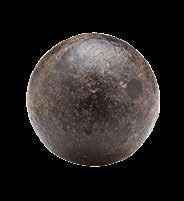



French designs on Colonial new south Wales
Francois Péron’s Memoir on the English Settlements in New Holland, Van Diemen’s Land and the Archipelagos of the Great Pacific Ocean
By Jean Fornasiero and John West-Sooby, published by Friends of the State Library of South Australia, 2014, 396 pages. Illustrations, bibliography, index.
ISBN 9781876154721 hardcover, 9781876154752 softcover.
RRP $65.00 hardcover, $35.00 softcover, $115.00 deluxe edition handbound in quarter leather
the PUBliC atiOn of an unfinished memoir by French naturalist and zoologist François Péron will reignite debate as to the real French motives for the voyages of l a Pérouse and nicolas Baudin in the late 18th and early 19th centuries, and the reasons for Britain’s claims for the whole of new holland, as australia was then known.
Professors Jean Fornasiero and John west- sooby began their own voyage ten years ago, after their earlier book with Peter monteath, Encountering Terra Australis – the Australian Voyages of Nicolas Baudin and Matthew Flinders (2004). t hey undertook research in France, before focusing on the Péron manuscript in the l esueur Collection at the museum of natural h istory at l e havre, the port from which the Baudin expedition embarked in October 1800. t he australian authors made the first complete english translation of the work.
Francois Péron was born in a llier in 1775 and grew up during revolutionary times. he joined the 2nd a llier volunteer Battalion in 1792, lost the sight of one eye in Prussia, and later studied medicine in Paris, without completing his degree. i n 1800 he offered to join nicolas Baudin’s expedition to the Pacific, which had the support of napoleon Bonaparte. a French government official noted, ‘ t he First Consul was pleased with the plan presented to him and … is disposed to order a voyage which will have for its main objective the exploration of the south west coast of new holland [australia], where europeans have not yet penetrated’.
t he authors write of l a Pérouse’s voyage, ‘ t here was … a tacit understanding at the
time that all voyages of scientific discovery had political significance of some kind or other’. Of the Baudin expedition, they add, ‘a lthough the voyage they were embarking on was strictly scientific in nature, it would inevitably be viewed with suspicion by rival european nations, whose own empires had been founded in many respects by similar undertakings’.
t he Baudin expedition set out with great anticipation, but met a series of misfortunes. when Geographe and its consort ship Naturaliste arrived in mauritius in march 1801, some sick sailors and scientists deserted ship, fed up with the autocratic command of Naturaliste ’s Captain hamelin. suddenly Péron became the expedition’s most senior scientist.
i n late may they reached Cape l eeuwin, at the south-west tip of new holland. at Geographe Bay Péron collected hundreds of specimens and noted the magnificent white-tailed black cockatoos. i n timor they replenished supplies, and some crew members who were showing signs of scurvy tried to recover their health. t he ships then sailed on to van Diemen’s l and (now tasmania); there they met local aboriginal people and collected plant species, finally leaving in February 1802 to explore and map the south coast of new holland, unaware of matthew Flinders’ voyage from england for the same purpose. i n an extraordinary coincidence, the French met Flinders’ ship travelling from west to east, the two ships pulling up near each other in calm seas.
t he French continued their voyage until, tired and unwell, they returned to the British colony at Port Jackson, where they

requested shelter to mend boats, bought supplies, and took sick crewmen to be cared for in the colony’s new hospital. t he authors write, ‘ the visit of over 170 officers, sailors and scientists, and the reprovisioning of their ships, would inevitably place a strain on the settlement’s resources’.
i n the colony Péron admired the emancipation of the convicts, the agriculture and thriving livestock, the roads and buildings. t he drawings and watercolours by the ship’s artist l esueur reinforce Péron’s studies of the colony. t hrough them we see its streets, buildings and army barracks, and the i ndigenous people, vegetation and animals.
Peron also saw that the settlement was unprepared for attack. he later wrote that an attack on Port Jackson from Botany Bay would be the most favourable for the French. ‘a s the distance between these two points is barely a league [5.5 kilometres], it is possible for troops disembarked from Botany Bay to find themselves in the centre of sydney town in three quarters of an hour.’
a fter five long months they were ready to leave. David h ill in his book The Great Race says, ‘By now the French almost had enough information from their own charts and those of earlier explorers to complete a map of the continent of australia’. t he persistence of the French caused the British to quickly set up settlements and lay claim to the whole of new holland.
Back in mauritius in september 1803, nicolas Baudin died of tuberculosis. t he two ships continued to l e havre under the command of Pierre Bernard m ilius
to unload their precious cargo of thousands of plant and animal specimens, some of which were destined for Josephine Bonaparte’s private zoo.
Péron gained permission to write the official report of the Baudin voyages, and also worked on his personal memoir. t he first volume, in which he claimed much of the credit for the voyage, was published in 1807. Péron died of tuberculosis in 1810, before finishing the second volume, which was completed by de Freycinet. i n 1811 the French published their complete maps, with drawings by l esueur of people and places they encountered.
Back in l ondon, matthew Flinders, very ill due to a six-year imprisonment on mauritius, finished his book A Voyage to Terra Australis it contained 16 maps, fine drawings and paintings, and gave the continent its modern name – australia. it was published on 18 July 1814. Flinders died the next day, aged just 40.
French Designs on Colonial New South Wales is almost shakespearean in scope, and the publication of Péron’s memoir in english gives us further insights into this history. it includes marvellous footnotes, Péron’s personal documents and letters, and a detailed bibliography for future scholars. t he authors have published a remarkable work, and are to be congratulated.
Margaret Smith
Reviewer Margaret Smith is a Sydney writer and filmmaker. Her recent film North of Capricorn (Ronin Films), inspired by Professor Henry Reynolds’ book, explores the effect of the ‘white Australia’ policy on the Asia–Pacific region over the past 200 years.

01 The cover depicts A View of Sydney Cove, engraving by Francis Jukes, London, 1804, from an engraving by E Hayes. National Library of Australia
02 Panorama of Port Jackson, CharlesAlexandre Lesueur, Muséum d’Histoire Naturelle, Le Havre, France – 16063.3
03 Plan of the town of Sydney, CharlesAlexandre Lesueur, Muséum d’Histoire Naturelle, Le Havre, France – 16074.2

By Phil Jarratt, published by Hardie Grant Books, Melbourne, 2014. Softcover, 288 pages, illustrations, notes.
ISBN 9781742705255
RRP $30 (Members $ 27.00)
i knew little a BOU t this BOOk or its subject matter when given it to review, but, from the title, expected an engaging account of a legendary bygone summer, which had far-reaching impacts on australian surf culture. i ended up reading a comprehensive history of Duke k ahanamoku – he doesn’t get to australia until chapter ten!
Far from covering a single summer, the book begins with Duke’s boyhood and spans the rest of his life. luckily he was a fascinating character who lived in interesting times. t he reader has plenty of time to get to know him as the book moves from hawaii to mainland Usa and europe (for the 1912 stockholm Olympics), before finally making it to Boomerang, a surf camp at sydney’s Freshwater Beach. On the way we meet other sporting greats and even novelist Jack l ondon, and learn more about Duke’s career as a competitive swimmer than about his surfing. it’s quite a journey.
Phil Jarratt has written several books on surfing and surfers and clearly knows his stuff. h is extensive research is evidenced by the exhaustive detail in the text and pages of notes and sources. But the comprehensiveness of the coverage slows the narrative at times. i n an author’s note, he says, ‘what began as a surfer’s mission to find out more about a surfing hero developed into an obsession’. a nd that’s very much the sense you get from the book; this is something the author cared about deeply and felt a need to set down correctly to do it justice.
Jarratt states, ‘ t his is not a work of fiction’ but admits he has ‘“joined the dots” in amplifying a sparsely reported event or in creating a personality from a faded photograph’. t his use of fiction as the mortar to join, fill and smooth gaps between blocks of definite fact has mixed success. where it’s done well, you skim over such inserts without questioning how he knew that’s what happened. But elsewhere the imagined conversations or mannerisms can seem a little clunky or clichéd, making the factual elements less convincing.
t he summer of the title is that of 1914–15, just before the landings at Gallipoli, and the australia featured is almost unrecognisable: bathing in the ocean has only just become legal and the surfside suburb of manly is just a series of home-built beach huts. Copies of old real-estate advertisements in the book’s endpapers reveal you could secure a property there for a one-pound deposit, with terms of ten shillings a month! i found this insight into bygone sydney fascinating, covering aspects of australian history largely skipped by other sources.
we follow Duke as he tours australia and new Zealand to compete at swimming and relax by surfing, drawing huge crowds for both, and meeting several australian surfing pioneers along the way. Black and white photographs within the text aid the imagination, revealing the characters described and the world they lived in. it’s slow going at times, but you have no difficulty empathising with the weary hawaiian swimmers as they’re dragged around the country for race after race in pools, rivers and even a flooded dry dock.
t he back-cover blurb makes much of the ‘entwined stories’ of Duke and australian teenager isabel l etham, but without wanting to give too much away, i’d describe them more as marginally overlapped than entwined. romance hunters are likely to be disappointed.
Despite feeling a little over-informed at times, i did learn a lot from these pages and would recommend this book to those interested in the history of surfing or swimming. Just don’t be fooled by the title and blurb; it isn’t (only) what it says on the box!
Em BlameyReviewer Em Blamey has been a creative producer at the museum since April 2013. She is currently developing an interactive exhibition for undereights called Voyage to the Deep, which is loosely based on Jules Vernes’ 20,000 Leagues Under the Seas and will open in December.

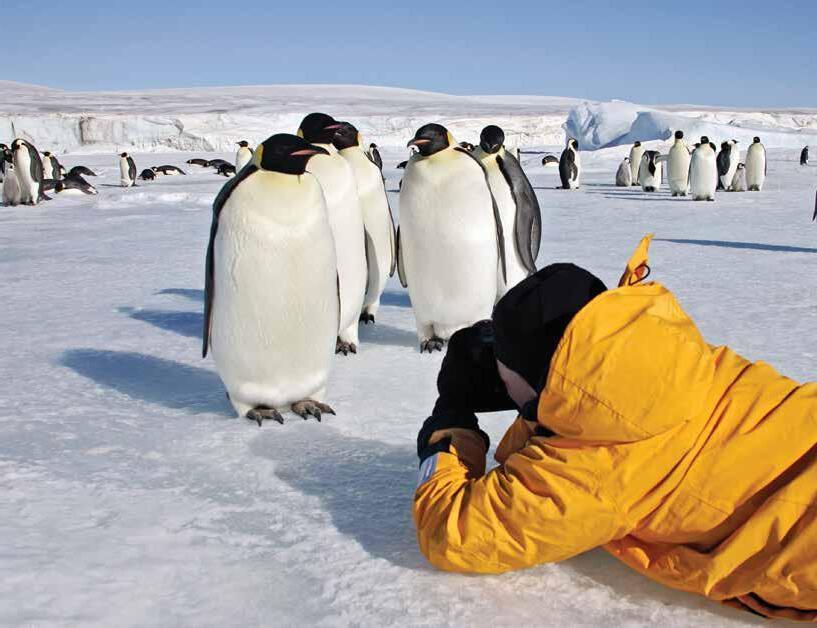
Considered
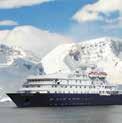
Enjoy an exclusive APT private charter aboard the
and
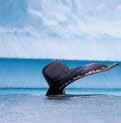
in 1928 the yOU nG Carl halvorsen was showing a talent for woodwork. he’d left school at 14 to work with his shipwright father, l ars, and brother harold in the sydney boatyard that this great norwegian boatbuilding family had established upon migrating to sydney in 1924. now, at 16, Carl was entrusted to fashion the 71-foot (21.6-metre) mast for a magnificent sydney yacht, harold nossiter’s Utiekah II –by hand, using an axe, an adze and a plane. Fifty years later, at the age of 76, Carl built new spars for the australian national maritime museum’s historic ketch Kathleen Gillett with those same hands and tools. t he 1988 restoration of this veteran of the first sydney– hobart yacht race, built to a famously seaworthy norwegian design for the australian pioneer yachtsman Jack earl, was funded by the norwegian government as its Bicentenary gift to australia.
Carl halvorsen, who has died peacefully one day short of his 102nd birthday, had been made a k night First Class of the royal Order of merit by k ing harald of norway for his efforts in the restoration of Kathleen Gillett, as well as for his lifetime contributions to boatbuilding and sailing, among other achievements and benefactions.
t hose contributions were warmly remembered at a gathering at the royal sydney yacht squadron this July by leading yachtspeople mourning the loss of a gentle and genial colleague who raced with kings and captains of industry and mixed with hollywood stars but was best known for his humility and generosity, his abiding friendships and his deep love for family.
Carl halvorsen was born in the southern norwegian hamlet of helle on 9 July 1912,
the son of boatbuilder l ars and his wife, Bergithe. he enjoyed an idyllic childhood, fishing in summer and skiing in winter. i n 1922, however, economic setbacks forced the family to move to to south a frica; two years later, the halvorsens settled in sydney. Carl soon joined his father and brother harold at the harbourside family enterprise, building timber work and leisure craft that would make the halvorsen name an australian byword for both quality and style. when l ars died in 1936, the family formed l ars halvorsen sons Pty ltd and expanded from their neutral Bay yard to build a stateof-the-art facility on the Parramatta r iver at ryde. while the firm was becoming known for the elegant luxury motor yachts they designed and built, world war ii saw the production of more than 250 boats for the a llied forces. Carl’s duties included testdriving the boats, and he joined the royal volunteer Coastal Patrol which guarded the waters of sydney aboard small armed craft.
a fter the war, Carl became marketing director of l ars halvorsen sons as it expanded to Bobbin head in the northern suburbs of sydney. t here began a booming business of renting out a fleet of the family’s practical and attractive timber cruisers on the hawkesbury r iver and Broken Bay. a s marketing director, Carl was seen with visiting international celebrities such as a lfred h itchcock, Burl ives, John m ills, ernest Borgnine and ronnie Barker. i n 1949, he travelled to l os a ngeles with the 60-foot (18.28-metre) luxury motor cruiser Tooronga to try the lucrative Us market. its fine lines and workmanship attracted attention, and Carl found himself socialising with hollywood stars including humphrey Bogart and Bob hope.
t hroughout his entire life competitive sailing was Carl’s passion. i n sydney, l ars and the boys built the little sloop Maud, in which Carl and his elder brother, harold, soon won their first sailing gold medal with the sydney a mateur sailing Club. a fter a decade of racing Dragons, Carl’s long career racing halvorsen-built 5.5-metre yachts began in 1967 when he won the australian Championship on Botany Bay in Crest t his was followed by australian Championships in 1982 and 1991 in Skagerak at the age of 80, he represented australia in the 1993 hanko 5.5-metre world Championships. i n the royal Prince a lfred Club’s Division 1 series in 2001–02, Carl – then aged 89 – won first place on Skagerak he raced Skagerak well into his 90s.
Carl was an office-holder of the royal sydney yacht squadron from 1958 to 1983 and was appointed a life member in 1981. he raced with the royal Prince a lfred yacht Club from the late 1960s and funded its Carl halvorsen scholarship, to encourage young people into the sport. a long with brothers magnus and trygve, he was awarded the 2000 australian sports medal.
Carl is survived by his daughter verity and was predeceased by his wife Glenagh in 1997. many would think that Carl’s longevity was due to an active and interesting life but, when asked, Carl attributed it to his enjoyment of sardines and a daily glass of red wine!
Randi Svensen and Jeffrey Mellefont
01 Carl photographed by Douglass Baglin.
02 Carl (right) aged about three, with elder brother Harold at Helle, Norway, c1915.
03 Carl with his wife Glenagh in about 1939.
04 Carl with Bob Hope aboard Tooronga, 1949.
05 Carl in front of the picture wall at the Bobbin Head office, which included images of Ronnie Barker, Alfred Hitchcock, Humphrey Bogart and of Carl aged 16 building the mast for Utiekah II (centre middle). All photographs courtesy Halvorsen family

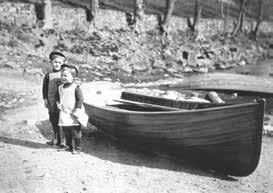



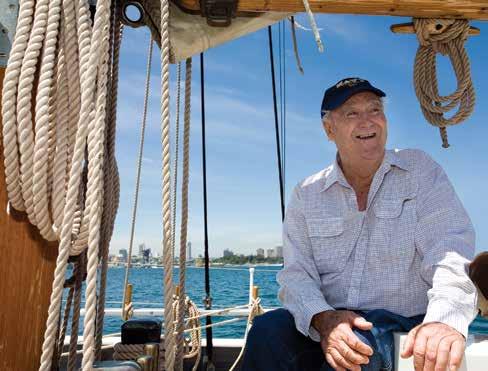
MORRIS, 13 FEbRUARy 1924–24 MARCH 2014
the wOODen ketCh Kathleen Gillett is one of the museum’s prized floating exhibits. it was a competitor in the inaugural sydney– hobart yacht r ace in 1945, one of the first australian yachts to circumnavigate the world, and the norwegian government’s Bicentenary gift to australia.
Kathleen Gillett is a living history of australian yacht racing and cruising going back 70 years. its voyage around the globe is recorded in Round the World in Kathleen, beautifully illustrated by its skipper, marine artist Jack earl, and superbly written by his first mate, m ick morris.
sadly, Kathleen’s skipper and first mate have now both hung up their sail bags – Jack earl some years back and m ick, at the age of 90, in march this year.
m ick had a remarkable and colourful maritime career, ranging from being a 19-year-old ‘admiral’ of a fleet of sailing luggers in new Guinea during world war ii to competing in the second sydney– hobart r ace in 1946, later in the admiral’s Cup and twice winning the prestigious scandinavian Gold Cup in the i nternational 5.5-metre class.
h is wartime career in new Guinea makes fascinating reading. a rriving at m ilne Bay as a member of the a rmy water transport Unit, he was interviewed by the colonel along these lines:
Now Sapper Morris, you know all about sailing? Yes sir. Good, now I want you to pick up nine pearling luggers at Bui Bui and start running from here with stores etc down to our base Kwiari, about 30 miles.
Well, there I was, AN ADMIRAL! Never seen a native in my life – no language, except signs – nine bloody great sailing vessels – no engines and 50 odd native crew.
‘admiral’ morris successfully commanded his flotilla for the rest of the war as the a llies moved forward, even shooting down a Japanese bomber. he ended with the rank of warrant Officer First Class, his final role being to return the luggers and other craft to the locals in new Guinea.
h is sailing career, which had started in dinghies in sydney, certainly didn’t end with the war. within a few months of discharge he was racing in the 1946
01 Mick Morris aboard Kathleen Gillett in 2008, on a sail organised by the museum to mark the 60th anniversary of the completion of the yacht’s circumnavigation.
02 Mick and Phyllis Morris aboard Kathleen Gillett in 2008.
Photographs A Frolows/ANMM

sydney– hobart in the big schooner Mistral t he following year he joined Jack earl and other crew members in their circumnavigation of the world.
i n the 1970s m ick joined Gordon i ngate as crew in the i nternational 5.5-metre class, winning the scandinavian Gold Cup and 5.5-metre world Championships in norway and sweden. i n 1975, m ick morris skippered his own boat Antares II to victory in the scandinavian Gold Cup, followed by a world Championship win in switzerland. to mark the 60th anniversary of the completion of Kathleen Gillett ’s circumnavigation, on 7 December 2008 the museum invited m ick, his wife Phyllis, and their family and friends for a sentimental sail on the fine old vessel.
m ick morris is survived by Phyllis, his wife of 63 years, their children Peter, Geoffrey, m ichael and vanessa and their families, including eight grandchildren and two great-grandchildren.
Peter Campbell
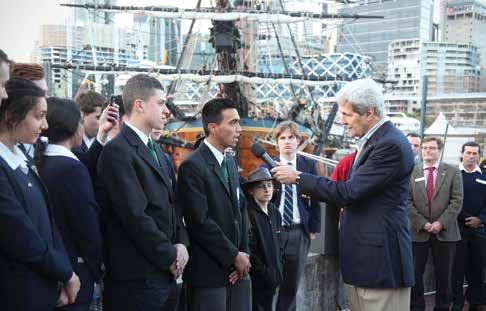
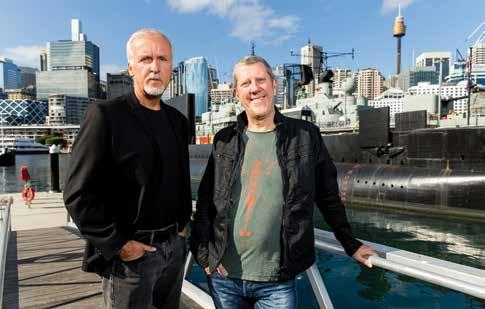

01 John Kerry aboard Endeavour
On 11 August, the United States Secretary of State, John Kerry, visited the museum for a tour of the HMB Endeavour replica. He also heard about the maritime archaeology work that the museum is doing in conjunction with the Rhode Island Marine Archaeology Project in the USA to search for the wreck of the original Endeavour in Newport Harbour, where (under the name Lord Sandwich) it was sunk during the American War of Independence. Mr Kerry also spoke to students from South Strathfield High School about ‘Our Ocean’, a conference hosted by the US Department of State in June, which canvassed sustainable fisheries, marine pollution and ocean acidification. He also met solo round-the-world sailor Jessica Watson, remarking that the energy and activism of younger leaders like Ms Watson were essential in setting a better course for our ocean.
Story by Janine Flew. Image Zoe McMahon/ ANMM
02 James Cameron and DEEPSEA CHALLENGER The USA Gallery Program is collaborating with Woods Hole Oceanographic Institution in Massachusetts to bring the DEEPSEA CHALLENGER submersible to the museum as the focus of a major new exhibition opening late in 2015. This is the vessel piloted by James Cameron almost 11 kilometres down to the bottom of the Challenger Deep in the Mariana Trench in 2012. It’ll be a bit like having the lunar lander from Apollo 11 on display, only in reverse! What makes it extra special is that the DEEPSEA CHALLENGER was built (in secret) in Sydney. So it’s an extraordinary example of the latest and best in maritime science and engineering exchange between Australia and the USA.
On 8 August James Cameron visited the museum for the theatrical release of James Cameron’s DEEPSEA CHALLENGE 3D a documentary film about his scientific expedition to the ocean abyss. He shared his enthusiasm for our project, which will focus on his great adventure and the science, technology, nature and fantasy of the alien world of the deep. Mr Cameron is pictured with director Ray Quint. DEEPSEA CHALLENGE 3D opened across Australia on August 21, and will be released on DVD and Blu-ray on 3 November.
Story by Richard Wood. Photo by Caroline McCredie/Getty Images for Beyond Films & Label Distribution
03 Banks’ Florilegium in Tokyo An exhibition at the Bunkamura Museum, Tokyo, late this year will examine Captain James Cook’s first Pacific voyage and the background to the publication of Banks’ Florilegium, one of its great scientific achievements. In June the museum welcomed Bunkamura curatorial staff Tomoko Mitani (left), Aki Hirokawa and (second from right) photographer Yuya Furukawa. They are pictured aboard the HMB Endeavour replica with ANMM staff Nigel Erskine (centre) and John Dikkenberg (far right).
Story Janine Flew. Photograph Andrew Frolows/ANMM

is an OBJ eC t mOre Or less fascinating the more we know about it? when the object in question is a lively black and white portrait of a charming but unidentified man, illumination only serves to make the image more captivating.
t he photograph belongs to the museum’s collection of anonymous portraits by sydney photographer william hall. t hese portraits have found their niche online, with audiences taking on the challenge of identifying their subjects. From soldiers to film stars, fashion designers and cabaret performers, names have been slowly coming forth – turning photos of strangers into portraits of people.
t he most recent identification has been that of popular singer and radio star vernon sellars. sellars features in two of hall’s portraits, one of which appeared in adelaide newspaper The Advertiser in January 1928. with the paper recently digitised, one of our regular online contributors (alias ‘Quasymody’) drew the connection between the article and our photograph, allowing us to accurately date and label the images, and to learn a little more about the man in front of hall’s lens.
i n the late 1920s, at the time hall was photographing sellars, he was already a well-known performer, appearing regularly at theatres across australia including the Capitol in melbourne, the t heatre royal in Perth and the majestic t heatre in newtown, sydney.
sellars was born in south australia in 1892 and studied at the prestigious elder Conservatorium in adelaide. a s with many of his generation, sellars’ career was interrupted by the outbreak of war and in september 1914 he enlisted in the australian i mperial Force. h is service took him as far as egypt, Gallipoli, l emnos and the western Front – locations now etched in australian military history. i n august 1918, sellars was wounded in action in France while serving as a stretcher bearer with the 1st australian Field a mbulance and he was transferred to the United k ingdom to recover. sellars remained in england after the armistice and resumed his musical career, entering the royal academy of music in l ondon and performing at the historic wigmore
hall. During this period sellars also studied under sir George Power, the i rish tenor who originally performed the legendary roles of r alph r ackstraw and Frederic in the Gilbert and sullivan operettas HMS Pinafore and The Pirates of Penzance. Power took an interest in sellars, whom he affectionately referred to as ‘my young soldier with the voice’.
a fter the war sellars married soprano Patsie h ill – another photogenic subject of our hall portraits and herself a successful star of the stage. together, vernon and Patsie appeared in many revues and pantomimes, becoming popular features on the theatre circuit under the management of J C williams, Fullers, tivoli and others. i n 1932 sellars supported the celebrated australian operatic soprano Gladys moncrieff at the winter Garden t heatre in Brisbane, ‘enchanting’ audiences with their duets.
sellars began working for radio station 3DB in 1930, taking his career in a new direction. he was the first announcer in australia to introduce the early morning session, and for many australians his familiar voice and bright ‘good mornings’ heralded the start of each new day.
During world war ii, sellars again enlisted for military service, joining one of the army’s Concert Party units where his musical talents were utilised to entertain and boost morale among troops. l ike many war veterans, sellars struggled with life after the war and his marriage to Patsie eventually broke down. he died in 1968.
several months ago, the internet aided another connection when vernon and Patsie’s granddaughter elizabeth contacted the museum after coming across the photographs online, kindly providing valuable biographical information about the couple. i was pleased to know that, even though their fame had faded, vernon and Patsie’s musical talents were still making a mark on the world in no small way – elizabeth is head of strings at monash University and next year will present a concert in memory of her grandfather as part of the anZ aC Centenary, playing many of the songs that sellars, in his day, had sung to his own captivated audiences.
Penny Edwell




COOK: FROM SAILOR TO LEGEND BY ROB MUNDLE
This extensively researched new biography of Captain James Cook will put you on the quarterdeck with the great navigator.
$33.00 / $29.70 Members
STOKER’S SUBMARINE
Australia’s daring submarine raid on the Dardanelles on the day of the Gallipoli landings.
$38.00 / $34.20 Members


TALL SHIPS TODAY
Tall ships epitomise the glamour, majesty and romance of the sea.
Nigel Rowe’s book shines a spotlight on the world’s most interesting and glamorous tall ships.
$69.95 / $62.96 Members
LIMITED EDITION PRIVATE MURRAY – THE DIGGER BEAR
Private Murray is beautifully presented in a branded box with certificate of authenticity.
Height 40 cm.
Limited edition of 5,000
$130.00 / $117.00 Members

FINDING LONGITUDE BY DUNN & HIGGITT
A beautifully illustrated and accessible history of longitude at sea and its consequences.
$55.00 / $49.50 Members
THE HISTORY OF WORLD WAR I IN PHOTOGRAPHS
Examines the causes of the conflict and charts its course on all the major fronts. Superbly illustrated with photographs from the Daily Mail archives.
$25.00 / $22.50 Members
WOODEN SYDNEY FERRY
This iconic wooden ferry is painted with authentic colours and based on the iconic First Fleet Sydney ferries. Length 40 cm
$120.00 / $108.00 Members

RAN NEXT OF KIN BADGE
The Royal Australian Navy badge was issued to the nearest female relative of a member of Australian forces who was on active service. Height 4.5 cm
$18.95 / $17.06 Members
Shop online at anmm.gov.au/thestore 9.30 am–5 pm 7 days a week | 02 9298 3698 | fax orders to 02 9298 3675 thestore@anmm.gov.au | Members discounts | Friendly service





Comments or questions about s ignals content?
Call the editor 02 9298 3777 email signals@anmm.gov.au
s ignals is online
Search all issues from No 1, October 1986, to the present at www.anmm.gov.au/signals
Signals journal is printed in Australia on Sovereign Satin
250 gsm (cover) and 128 gsm (text) using vegetable-based inks on paper produced from environmentally responsible, socially beneficial and economically viable forestry sources.
Cert no SGS-COC-006189
01 HMT Zealandia in Sydney Harbour iduring World War I, wearing her ‘dazzle’ camouflage. ANMM Collection
Australian National
Maritime Museum
Open daily except Christmas Day
9.30 am to 5 pm (6 pm in January)
2 Murray Street Sydney NSW 2000
Australia Phone 02 9298 3777.
The Australian National Maritime Museum is a statutory authority of the Australian Government.
b ecome a museum Member
Benefits include four issues of Signals per year; free museum entry; discounts on events and purchases; and more. See anmm.gov.au or phone 02 9298 3644. Corporate memberships also available.
ANMM council
Chairman Mr Peter Dexter am
Director Mr Kevin Sumption
Councillors
Mr Paul Binsted
Mr Robert Clifford ao
Mr John Coombs
Rear Admiral T W Barrett am csc ran
Mr Peter Harvie
Mrs Robyn Holt
Dr Julia Horne
Mr Shane Simpson am
Ms Eva Skira
Mr Neville Stevens ao
Signals
ISSN 1033-4688
Editor Janine Flew
Staff photographer Andrew Frolows
Design & production Austen Kaupe
Printed in Australia by Pegasus Print Group.
Material from Signals may be reproduced, but only with the editor’s permission.
Editorial and advertising enquiries
Janine Flew 02 9298 3777 signals@anmm.gov.au
Deadline mid-January, April, July, October for issues March, June, September, December
Signals back issues
Back issues $4 10 back issues $30
Extra copies of current issue $4.95
Call The Store 02 9298 3698
Foundation partner ANZ
Major partners
Accor’s Darling Harbour Hotels
Lloyds Register Asia
Nine Entertainment Southern Cross Austereo
Partners
Australian Pacific Touring Pty Ltd
Decorative Events & Exhibitions
Destination NSW
History Channel
Major League Baseball
Metropolitan Touring Ecuador
National Geographic Australia
Professional Footballers Australia
Royal Wolf Holdings Ltd
Sydney by Sail
Founding patrons
Alcatel Australia
ANL Limited
Ansett Airfreight
Bovis Lend Lease
BP Australia
Bruce & Joy Reid Foundation
Doyle’s Seafood Restaurant
Howard Smith Limited
James Hardie Industries
National Australia Bank
PG, TG & MG Kailis
P&O Nedlloyd Ltd
Telstra
Wallenius Wilhelmsen Logistics
Westpac Banking Corporation
Zim Shipping Australasia
ANMM GOV AU